
- Customer Reviews
- Net 30 Account
- Wise Services
- Steps & Timeline
- Work at a Glance
- Market Research at a Glance
- Business Plan Writing Services
- Bank Business Plan
- Investor Business Plan
- Franchise Business Plan
- Cannabis Business Plan
- Strategic Business Plan
- Corporate Business Plan
- Merge and Acquisition Business Plan (M&A)
- Private Placement Memorandums (PPM)
- Sample Business Plans
- Professional Feasibility Study
- PowerPoint Presentations
- Pitch Deck Presentation Services
- Business Plan Printing
- Market Research
- L-1 Business Plan
- E-2 Business Plan
- EB-5 Business Plan
- EB-5 Regional Centers
- Immigration Attorneys
- Nonprofit Business Plan
- Exit Business Planning
- Business Planning
- Business Formation
- Business License
- Business Website
- Business Branding
- Business Bank Account
- Digital Marketing
- Business Funding Resources
- Small Business Loans
- Venture Capital
- Net 30 Apply


How to Write a Business Plan Cover Page Complete Guide with Examples
Fill the form to download business plan cover page examples.
A business plan cover page may not come to mind when you think of writing your business plan. Although it’s traditionally one of the last sections of a business plan, it’s one of the most crucial.
Your business plan only has one chance to make a good impression on your reader. The cover page of a book or business plan can easily make a person make a decision.
In this article, we will explain the importance of business plan cover pages and provide a step-by-step guide to help you create your own cover page for your business plan. See our real world business plan examples to see what should be included in the other sections of your business plan.
What is a business plan cover page?
The cover page of a business plan summarizes all the important aspects of the business and serves as an introduction to the full business plan. Bankers and investors can quickly determine the purpose of a business plan by viewing the cover page.
You should include the name of your company, your logo, addresses, and other information that identifies your business. This is the first page of your plan, so it should look professional, visually pleasing, and informative.
What is the purpose of a cover page?
The purpose of the cover page is to communicate what the document enclosed is and to provide information that enables a reader to contact you about your business.
Make sure your business plan’s cover page is visually appealing, free of errors, and concise to set the tone for its content.
A strong business plan cover page should be simple, clean, and powerful. Don’t clutter your cover page with details about how your business will operate. Save those details for the executive summary .
Whether you are writing a business plan , marketing plan, or proposal, the business plan cover page is an essential part of your plan. Read on to find out which elements your business plan cover page should contain and how to design it for maximum impact.
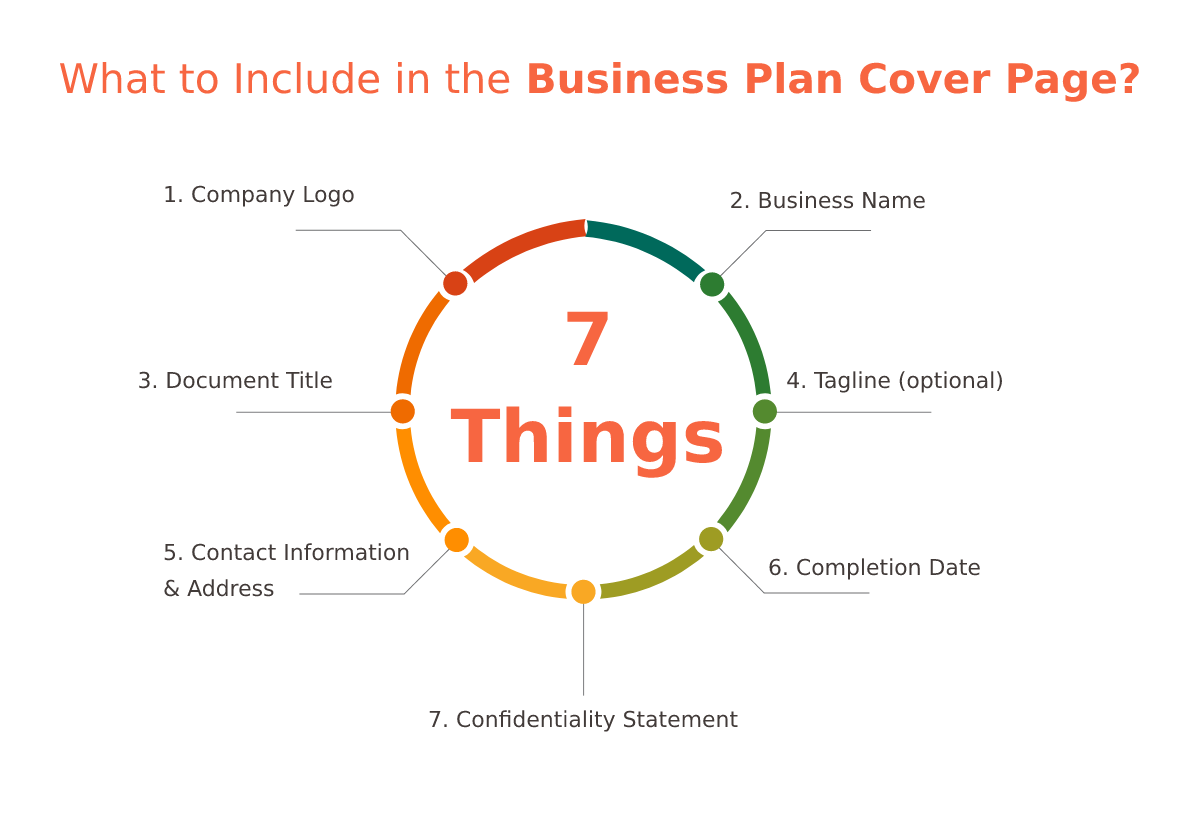
What to Include in the Business Plan Cover Page?
Although there are no specific rules regarding what should be included on your business plan cover page, we have prepared some essential information that you should not overlook.
Company logo
- Business name
- Document title
- Tagline (optional)
- Contact information and address
- Completion date
- Confidentiality statement
Now let’s look at each of these elements in greater detail so you know what you need to include on your business plan cover page.
1. Company Logo
Use a neat, clean, high-quality logo to make your business plan cover page look professional. The logo should be placed at the top of the page.
The image should be large enough to see details, but not so large that it becomes a distraction. Brand identity begins with your logo. The company logo is the first and most significant section that will capture your readers’ attention immediately.
People are 90% more likely to remember your logo if you place it in the top left corner.
2. Business Name
After the company logo, your company name is the second most important section of your cover page as you want your reader to remember your company name as they read the document.
To make your company name stand out from the rest of the information on the business plan cover page, you should use a readable, bold font that is the largest font on the page.
Please keep in mind that if your company logo includes your company name, you can remove either your company logo or name from the cover page.
You can download 50+ Free Business Plan Templates here that include not only pre-built cover pages but also provide step-by-step guidance in the creation of your entire business plan.
3. Document Title
Plan titles tell the reader immediately what the document is about, whether it is a business plan , marketing plan, expansion plan, recovery plan, or anything else.
It is commonly referred to as a “Business Plan,” but you can also customize it by saying “Five-Year Business Plan” or “Merger Business Plan” if you want to outline more specific objectives.
The title of the plan should be large and prominent on the cover page. Readers should know the purpose of the document immediately.
Increase readability by using a clear, bold font, such as Times New Roman, Garamond, or Arial. It may be difficult to read script lettering and doesn’t appear professional.
Please Note: Make sure your name isn’t more prominent than your business plan title cover page.
4. Tagline (optional)
Business owners sometimes use taglines to describe what they do and how they’re different. It’s optional, but you can also include a catchy slogan or motto describing your business.
A tagline becomes an essential part of your cover page if you want your reader to immediately understand what you do.
Generally, your business plan will be more interesting to investors or readers if the tagline is memorable. A business tagline is a short catchy marketing slogan that signifies your brand or company name, as well as other important aspects of your business.
Create a tagline by describing what you do in a few words. Put your tagline under your company logo on your cover page so readers understand what you do immediately.
5. Contact Information and Address
“Prepared By” contains contact information the reader can use to contact the person. It includes information about the company’s mailing address, phone number, e-mail address, and website.
To make investors aware of where to direct their inquiries, include your name as the business owner as well as the names of any partners or executives.
Try to center this information on the page to maintain consistency in formatting. As long as the information is clearly visible and readable, you may use a smaller font size than you used for the company name and title.
6. Completion Date
When was this plan written? The date is important to readers, so include it (month and year are sufficient).
Under the contact information, write the year (or the year and month) in which the business plan was finalized and published. It’s a good idea to update your business plan throughout the year if you’re including the month, so readers don’t think it’s old.
It is important to note that your company name should appear more prominently than your title and date. Depending on your business plan’s writing style, you may spell out the date, like Jan 20, 2023, or write it numerically, like 20/1/23.
Dates should be formatted consistently throughout the document. To maintain consistency, center the text and use the same font size as your address and contact information.
7. Confidentiality Statement
Adding a confidentiality statement to your cover page protects your idea from being disclosed. It is not required, but you may want to include a confidentiality statement on the cover page, or just text “Confidential” to emphasize that this is a confidential document such as the following:
Example of Confidentiality Statement
It is understood that the information provided in this [Company’s Name] Business Plan is totally confidential, and the reader undertakes not to disclose any aspect of it without the express written consent of the business owner.
How to write a business plan cover page that captures investors' attention?
- Keep it concise and to the point: Investors are busy people, so they don’t want to read a long and rambling cover page. Keep your cover page brief and to the point, highlighting your key business strengths and unique selling points.
- Use clear and concise language: Avoid using jargon or technical language that your target audience may not understand. Use clear and concise language to communicate your business vision and goals.
- Highlight your key business strengths and unique selling points: What makes your business unique and different from the competition? What are your key strengths? Highlight these things on your cover page to grab investors’ attention.
- Make sure your cover page is visually appealing and professional: Your cover page is the first thing that potential investors will see, so it’s important to make a good impression. Use a professional design and layout, and avoid using too many colors or fonts.
- Proofread carefully for any errors: Typos and grammatical errors on your cover page will make you look unprofessional. Proofread your cover page carefully before submitting it to any potential investors.
What are some creative business plan cover page design ideas?
- Use high-quality images or graphics that are relevant to your business: Images and graphics can be a great way to add visual interest to your cover page and make it more engaging for potential investors. Choose high-quality images or graphics that are relevant to your business and that will help to communicate your brand message.
- Use a unique and eye-catching font scheme: Your cover page should stand out from the crowd, so use a unique and eye-catching font scheme. Avoid using overused or generic fonts.
- Use your company colors and branding to create a cohesive look: Your cover page should be consistent with your overall branding. Use your company colors and fonts to create a cohesive look and feel.
- Keep your design simple and elegant: A simple and elegant design is often the most effective. Avoid cluttering your cover page with too much text or too many images and graphics.
Are You Looking for a Customized Business Plan Template?
It only takes 3 proven steps to complete your business plan with our custom-designed business plan template Trusted by thousands of businesses with a 30-Day Money-Back Guarantee!
What makes a great cover page for a business plan
Formatting should be consistent.
Messy or unprofessional cover pages can create negative perceptions in your readers’ minds before they even open your business plan.
The cover page of your business plan is the first impression of your company, so your logo, fonts, and brand colors should all work together to capture the reader’s attention.
Follow these best practices to create a cover page that stands out:
Keeping your cover page neat and consistent will allow your reader to perceive your organization and professionalism. Use consistent formatting through
- Maintaining equal spacing between characters and lines
- Choosing fonts that are similar or identical
- Make sure each line of your cover page is centered
When it comes to fonts, it’s best practice to stick to one type of typeface, such as serif or sans serif. It’s also important to choose fonts that are simple, easy to read, and represent your brand.
It is important to ensure your business plan’s cover page is free of spelling and grammatical errors. Make sure you proofread your document several times before publishing the final version, and ask others to review it as well.
The less the better
In your business plan executive summary , you will summarize its contents. The cover page should not do the same. It is also unwise to create a business plan cover that is graphically complicated because the information will be difficult to discern. A strong business plan cover page should be simple, clean, and powerful.
Make use of the color scheme of your company
Color plays a crucial role in establishing your brand’s credibility and trustworthiness. Choosing the right brand color will reveal more about your business than you could ever imagine.
In addition, using the right colors can enhance your brand value by creating a strong visual identity. To make your business plan more appealing, your brand color should be incorporated everywhere, such as titles, subtitles, features, images, etc.
Ensure the colors don’t distract from the important information and consider coordinating them with your company’s brand or logo.
Colors represent 90% of your brand’s personality and elicit the right emotions from your customers, so choose colors that represent your brand’s personality and evoke the right emotions.
When it comes to choosing a logo, simplicity is key. Try to create something that represents your brand and speaks to your audience without being too busy (in other words: white space is your friend).
It’s also important to remember to be practical: your logo should look good in any medium, size, color, and even time period. Beyond your business plan cover page, you’ll need it for your social media, marketing material, or labels.
Download Pack of 6 Business Plan Cover Page Examples
We will show you some real-world business plan cover page examples so you may know how to design your own.
Download Business Plan Cover Page Templates
Here are a few business plan cover examples to illustrate the structure and format. Download and customize it according to your needs.

Business Plan Cover Page Example 1

Business Plan Cover Page Example 2
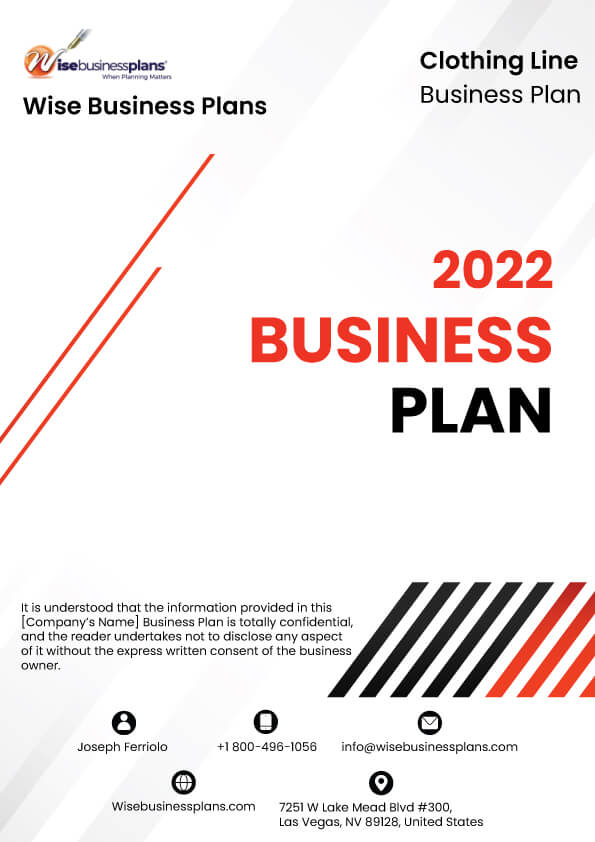
Business Plan Cover Page Example 3
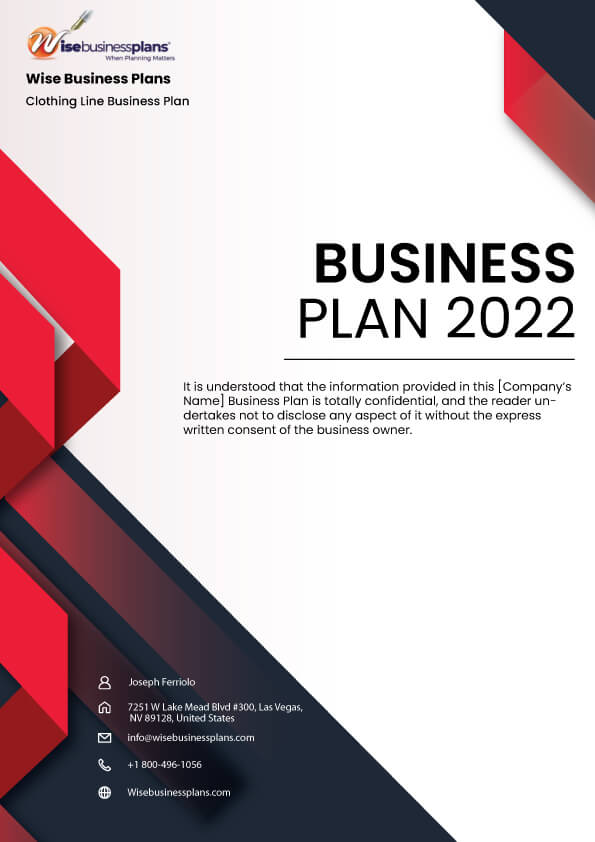
Business Plan Cover Page Example 4
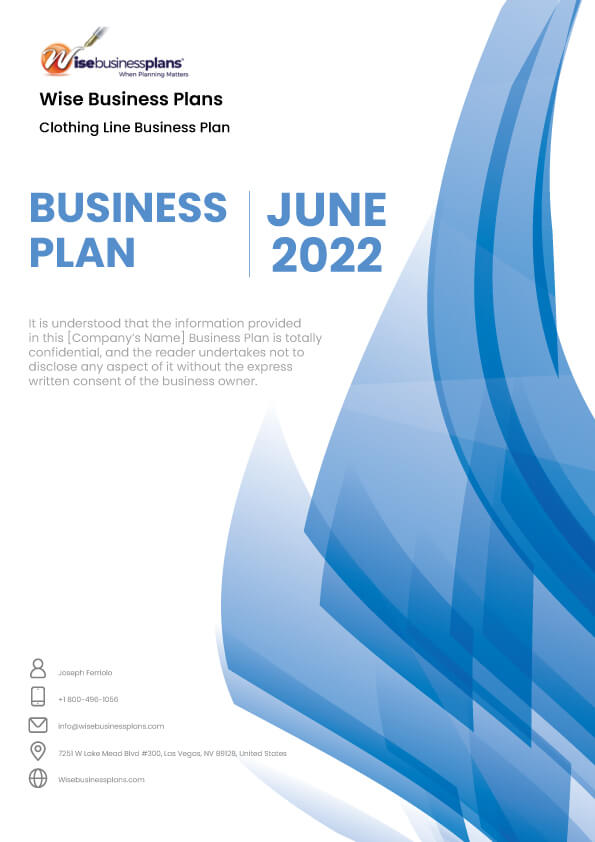
Business Plan Cover Page Example 5

Business Plan Cover Page Example 6
If you’re not confident in your ability to create a business plan on your own, or if you simply don’t have the time to do so, Wise Business Plans can help.
Our expert business plan writers have years of experience crafting comprehensive plans for businesses of all sizes and industries. We’ll work with you to understand your unique vision and goals, and we’ll create a customized plan that outlines your marketing strategy, target market, financial projections, and more.
Articles & Templates Related to Business Plans

Real Sample Business Plans for Small Business

How to Write a Business Plan

Expert Business Plan Writer

How to Write One Page Business Plan

25 Reasons Why You Need a Business Plan

How to Write an Effective Executive Summary with Examples

Dozens of Business Plan Templates for Different Industries

Common Mistakes to Avoid When Writing a Business Plan
How Much Does a Business Plan Cost?
Quick Links

- Investor Business Plans
- M&A Business Plan
- Private Placement
- Feasibility Study
- Hire a Business Plan Writer
- Business Valuation Calculator
- Business Plan Examples
- Real Estate Business Plan
- Business Plan Template
- Business Plan Pricing Guide
- Business Plan Makeover
- SBA Loans, Bank Funding & Business Credit
- Finding & Qualifying for Business Grants
- Leadership for the New Manager
- Content Marketing for Beginners
- All About Crowdfunding
- EB-5 Regional Centers, A Step-By-Step Guide
- Logo Designer
- Landing Page
- PPC Advertising

- Business Entity
- Business Licensing
- Virtual Assistant
- Business Phone
- Business Address
- E-1 Visa Business Plan
- EB1-A Visa Business Plan
- EB1-C Visa Business Plan
- EB2-NIW Business Plan
- H1B Visa Business Plan
- O1 Visa Business Plan
- Business Brokers
- Merger & Acquisition Advisors
- Franchisors
Proud Sponsor of
- 1-800-496-1056

- (613) 800-0227

- +44 (1549) 409190

- +61 (2) 72510077

Sign up for our newsletter for product updates, new blog posts, and the chance to be featured in our Small Business Spotlight!

How to write your business plan cover page

When you think of putting together your business plan , the business plan cover page may not be the first thing that comes to mind. While it’s traditionally one of the last sections you create in a business plan, it’s one of the most important.
Definition: What is a business plan cover page?
The cover page of a business plan is used to give an overview of all the key information of your business. This includes your company name, logo, address, and any other information that may define your business. It's the first page of your plan, so it should look professional, visually pleasing, and informative.
When potential investors or banks read a business plan, their first impression is the cover page—but don’t overthink it. A business plan cover page is meant to be simple and straightforward, with some important contact information and, more importantly, your logo.
Use this breakdown to find out what the purpose of your cover page is, which elements you need to include, and how to structure it to maximize your impact:
What is the purpose of a cover page?
Your cover page exists to communicate what the enclosed document is and to provide the necessary information for a reader to contact you about your business.
The appearance and quality of a business plan cover page will set the tone for your business plan’s content, so make sure it’s visually appealing, free of errors, and concise.“ Simple, clean and powerful are the three goals of a strong business plan cover,” suggest the experts at Growthink . Don’t clutter your cover page with details about how your business will operate—save those important details for the executive summary .
What should you include on a business plan cover page?
To keep it simple, your business plan cover page should include:
Company logo
- Document title
- Business name
- Business address and contact information
- Business plan completion date
- Confidentiality statement
How should you format a business plan cover page?
Once you know what information belongs in this section, all that remains now is to organize it. If you need some further guidance, these downloadable templates can streamline the process of drafting a cover page—and the rest of your business plan, too.

1. Company logo
Add a high-resolution thumbnail of your logo at the top of the cover page. This will help establish a brand identity and allow readers to connect visually to the business right from the start.
Hot tip: people are 89% more likely to remember your logo if you put it in the top left corner.
Give the logo some space and then include the words “Business Plan” in a large, bold font. You can also frame the title as “Three–” or “Five–Year Business Plan,” if you intend to make those kinds of financial projections in the document.
3. Business name
Beneath the title, write your company name in a bold font. This should be the most noticeable and prominent feature on the page, so choose a large typeface.
4. Tagline (optional)
This part is optional, but you can also include a catchy slogan or motto that describes your company and what you do.
5. Address and contact information
Under the company name, include your business’s physical address and website if you have one. Provide the details necessary for interested parties to contact you, such as a phone number and email address.
It’s also helpful to include your name as the business owner and the names of any partners or executive officers so that potential investors know where to direct their inquiries.
6. Date of completion
Below the contact information, write the year (or year and month) in which this business plan was finalized and issued. If you’re including the month, it’s a good idea to update it throughout the year as you send out your business plan so readers don’t assume it’s outdated.
7. Confidentiality Statement
At the bottom of the page, include a sentence to the effect of:
“This document contains confidential and proprietary information created by [business name]. This document is issued exclusively for informational purposes and should not be reproduced without the consent of [business name].”
Adding this confidentiality statement offers a protective measure against the disclosure of your business idea , according to this cover page guide .
Send invoices, estimates, and other docs:
- via links or PDFs
- automatically, via Wave
*While subscribed to Wave’s Pro Plan, get 2.9% + $0 (Visa, Mastercard, Discover) and 3.4% + $0 (Amex) per transaction for the first 10 transactions of each month of your subscription, then 2.9% + $0.60 (Visa, Mastercard, Discover) and 3.4% + $0.60 (Amex) per transaction. Discover processing is only available to US customers. See full terms and conditions for the US and Canada . See Wave’s Terms of Service for more information.
Send invoices, get paid, track expenses, pay your team, and balance your books with our financial management software.
Cover page design
Now it’s time for the finishing touches: the actual design of your cover page. Your business plan’s cover page gives the first impression of your business, so your company logo, fonts, and brand colors should all work together to make people want to read more.
Brand colors
90% of a customer’s impression of your business comes from the brand colors you choose, so it’s important to choose colors that represent your business’s personality and elicit the right emotions from your readers.
Don’t know where to start? Grab a pen and paperand write down three emotions you want your customers to feel when they think of your brand. Now you can brainstorm some colors that represent those emotions. For example, you might choose blue if your product is associated with reliability, or yellow if your product is supposed to make your clients feel happy. It’s safer to only choose 2-3 colors , including black, for your color scheme.
You can also analyze the competition and choose colors that help you stand out. Canva has more detailed instructions on how to create your brand color palette .
When it comes to fonts, it’s best practice to stick to one type of typeface, such as serif or sans serif . It’s also important to choose fonts that are simple, easy to read, and represent your brand.
Serif fonts give off the impression that your brand is trustworthy and dependable, and work great for more traditional businesses, like law practices. “Serif fonts have been widely used in books, newspapers, and magazines, which is why they remind us of more classical, formal and sophisticated themes—think of Old English and Roman scripture,” Robyn Young, founder of branding agency robyn young & co, told Canva .
But if you’re going for a more contemporary and youthful feel, then sans serif is the way to go. “Brands that want a modern aesthetic that scales well at different sizes and is easy to read on screens are going to choose sans serif for their main branding elements,” said Young .
When it comes to choosing a logo, simplicity is key. Try to create something that represents your brand and speaks to your audience without being too busy (in other words: white space is your friend).
It’s also important to remember to be practical: your logo should look good in any medium, size, color, and even time period. Beyond your business plan cover page, you’ll need it for your social media, marketing material, or labels.
Business plan cover page examples
To further illustrate the structure and format of a business plan cover page, we’ve compiled a few cover page template examples. The first example from officetemplatesonline is simple but attractive and effectively emphasizes pertinent information. The next cover page example is from a fictional clothing store . They usea pop of color to instantly tell you about their brand personality.
Keep your business plan cover page simple
As you prepare to write your business plan , remember to keep your cover page simple and concise. With your logo, business name, and contact information, you’ll introduce the reader into your business plan quickly and easily—and set yourself up for success as a result.
Just don’t forget to proofread and keep an eye out for typos!
Business plan cover page FAQs
How can businesses make sure their business plan cover pages stand out to investors or lenders.
You can spice up your business plan cover page by including elements that’ll grab the attention of investors or lenders. Beyond basic contact information and a logo, you could include compelling visuals, like graphics or images that represent your business or industry. You could also highlight key achievements or milestones to showcase your potential for success
Are there any specific rules or tips for designing a business plan cover page that make sure it matches a business’s brand?
When designing a business plan cover page, it's key to align it with your business's brand identity. This means choosing colors, fonts, and imagery that reflect your brand's personality and values. Following industry standards for design and layout can help ensure professionalism while still allowing for creativity that helps your business stand out.
How can a business use their cover page to show their business strategy?
Your cover page can serve as an opportunity to convey important aspects of your business strategy or unique value proposition. Beyond listing basic details, you could include a brief mission statement or tagline that summarizes your business’s purpose or competitive advantage. Additionally, incorporating visual elements or a brief narrative about your business's story can help show off its identity and vision.
Related Posts
Let our How to Start a Business Playbook guide the way.
The information and tips shared on this blog are meant to be used as learning and personal development tools as you launch, run and grow your business. While a good place to start, these articles should not take the place of personalized advice from professionals. As our lawyers would say: “All content on Wave’s blog is intended for informational purposes only. It should not be considered legal or financial advice.” Additionally, Wave is the legal copyright holder of all materials on the blog, and others cannot re-use or publish it without our written consent.

Everything you need to know about business plan cover pages
You have only one chance to make a good first impression with the readers of your business plan.
People do judge books—and business plans—by their covers. A quick glance at the cover can easily be enough to make up one’s mind.
So set yourself up for success with a powerful cover page that stands out and entices the reader to find out more about your business.
Here’s everything you need to know:
Definition: What is a Business Plan Cover Page?
Cover page (also known as title page or cover sheet) is the first page of a business plan that communicates what the enclosed document is about and highlights the key company information like name, logo and contact details, making a good impression with professional and attractive appearance.
Purpose: Why is Business Plan Cover Page Important?
Many businesses spend hours preparing their business plans but then do not pay enough attention to the title page. This is a huge mistake .
5 ways a strong cover page can help you make a positive first impression:
- Clearly indicate what the presented document is about
- Provide the necessary information for a reader to contact you
- Create a powerful first impact that sets the stage for how readers will engage with your document
- Avoid falling victim to negative preconceived notions as a result or unprofessional or unattractive cover
- Maximize the chance of the plan being read by making the document stand out from the crowd and immediately drawing your reader’s attention
Keep reading to find out which elements you need to include in the cover page, how to structure it to maximize the impact of your business plan, and to take a look at some successful examples .
Contents: What Should You Include in a Business Plan Cover Page?
Surprisingly, there are no strict rules about what to show on your business plan cover sheet, but there certainly are best practices that you should follow.
Here are 9 elements that are typically included on business plan covers, 3 of which are essential and you should not miss to include them. The remaining 6 are optional for your consideration.
| Business Plan Cover Page Contents | |
|---|---|
| Must-haves | Nice-to-haves | Company Logo |
| Tagline | |
| Document Title | Date |
| Version Control | |
| Disclaimer | |
| Contact Info | Visuals |
1. Must-haves: 3 mandatory cover page elements
1.1. Business name: The name of the company that is the subject of the plan.
1.2. Document title: The words “ Business Plan ” in a prominent spot so that it is clear what kind of document this is.
1.3. Contact information: Name, title and contact details (e.g., phone, email, social media, website, address) of the primary contact persons presenting the plan (e.g., CEO, Founder, Owner, President) so that any interested parties know exactly to whom to direct their inquiries and can reach them quickly and easily.
2. Nice-to-haves: 6 optional cover page elements:
2.1. Company logo: The logo of the company if available and desired.
2.2. Tagline: Short, memorable summary of the business described in the plan.
2.3. Date: In order to make sure your plan does not look outdated, include only the year of the business plan completion date. If you are including both the month also, it is advisable to create a new cover sheet each time you send out the plan.
2.4. Version control: Numbering each copy of the plan enables you to more easily keep track of who you sent what version of the document to.
2.5. Disclaimer: Disclaimer can help protect you and your company from confidentiality and other legal issues resulting from the distribution of the business plan by indicating that the plan is for information only, not an offering of stock in the company, and not to be shared with third parties without your prior consent.
2.6. Visuals: Graphic elements or images to enhance the professional look and visual appeal of the document.
![Business Plan Cover Page: Complete Guide [+ Examples] 5 Structure of business plan cover page with all attributes, essentials and typical](https://www.companyplan.com/wp-content/uploads/2020/09/cover-page-structure-business-plan-cp-768x384.jpg)
Let’s have a more detailed look at these cover page elements so you know what exactly to include into each of them:
Business Name
The most prominent feature on your business plan cover is the name of your company.
Instantly, the reader should notice the name of your business. In fact, if readers take away nothing else from the cover page, they should remember your company’s name.
As this is the most noticeable feature on the page, use a large font that stands out, but is easy to read, looks professional and corresponds to the typeface that you used for the rest of the document.
Company Logo
Placing a high-quality company logo on the cover page helps to make the business plan look more professional and establish a brand identity by allowing readers to connect visually to the business right from the beginning.
If your logo includes the full name of the company, you do not have to display both the company name and logo on the cover page, it is sufficient to choose one of the two.
Document Title
The readers need to know what the presented document is about – immediately and clearly.
The cover page should clearly state whether it is a Business Plan, Executive Summary, Financial Forecast, Marketing Plan, Recovery Plan, or any other kind of plan.
For example, write the words “ Business Plan ” in a prominent spot on the cover sheet to make it crystal clear what type of document this is. You may include any additional words that are part of the title, such as “Three/Five-Year Business Plan” if needed or relevant.
As a focal point on the cover page, the document title should be in a large font size .
There is no rule though about whether the Document Title or Company Name and Logo should be of the largest font size, as all are of key importance. So it is entirely your decision what feature you prefer to highlight on the cover page of the document.
Contact Information
Contact details should always be on the business plan cover page, letting the reader know who is presenting the document and how to contact them if they need more information.
It is helpful to indicate the names and titles of the company’s primary contact persons for investors and other business plan readers, such as:
- External distribution: company founder, owner, president, partner, CEO
- In-house corporate plans: head of division, departmental manager, executive officer
Next, provide the contact details that will allow the interested parties to reach these primary contact persons quickly and easily, including:
- Name and title of primary contact(s)
- Phone number
- Email address
- Social media handles
- Website address
- Postal address
The contact information is typically displayed in the smallest font on the cover page.
Company tagline, or a motto , is a catchy memorable marketing slogan that captures the essence of a business in a few short and simple words: >> What you do >> How you do it >> Why are you different from the competition
For example, you will undoubtedly recognize the following company mottos:
| Company Motto: Examples | |
|---|---|
| Company | Tagline | "Just Do It." |
| Apple | "Think Different." |
| McDonald's | "I'm Lovin' It" |
| De Beers | "A Diamond Is Forever" |
| L'Oreal | “Because you’re worth it” |
| Dollar Shave Club | "Shave Time. Shave Money." |
As such, the tagline is a useful part of the cover page as it helps the business plan readers better understand what you do straight away, and even excite them to read the business plan and study it with more interest.
When was this business plan finalized and issued ? The readers will be interested to know. Hence, it is advisable to state the document completion date on the cover page.
Strictly speaking, you do not need to denote anything more specific that the year in which you completed the business plan. (“Business Plan: 2021”) This will ensure that the plan does not appear outdated for an entire year.
Imagine that you are a potential investor who in December 2021 receives a business plan dated January 2021. It would be natural to assume that the document has been rejected many times by other investors over the last 12 months.
Alternatively, you can include both the current month and year on the cover sheet. (“Business Plan: January 2021”) Each time you update the document and send it out or present it, you will need to check if this date of completion needs updating .
The date is featured on the cover sheet less prominently and in a smaller font size than the document title and company name, and is often displayed below the plan title.
Version Control
As your business develops, you may revise your business plan any number of times and send it to multiple recipients . To keep track of the different versions of the plan that you produce and which version you sent to whom, you may decide to use a version control system.
However, it does not make the best impression when someone receives a “Version 25” of your plan.
Instead, consider devising a simple coding system . For example: “Copy D.5” would indicate it is the fifth copy of a fourth version of the document or “Version 4.5” could mean a fifth copy of a document version completed in April.
Numbering each copy of your business plan before distribution, and keeping a list of which individual has received which copy, would enable you to keep track of how many copies are in circulation, and, if needed, ask to have a copy returned, or trace the responsible party in case a copy is circulated without your permission.
Confidentiality Statement & Disclaimer
Why should your plan include a disclaimer.
Legal issues may arise as a result of circulating your business plan.
For example, anyone who is in the possession of the document could potentially divulge the confidential information.
Also, in some countries, offering ownership in your company in return for an investment is considered as selling of stock, which is a regulated activity. The best way to protect yourself is to consult a lawyer.
Nevertheless, including a disclaimer in the business plan helps to protect your company by indicating the plan itself is not an offering of stock for sale but rather a document for information purposes only.
The same disclaimer can also be used to help protect the confidentiality of the information disclosed in your business plan by informing the reader that the plan is confidential and not to be shared with other parties without the owner’s consent, especially when you are not adding a non-disclosure agreement.
What Should the Disclaimer Say?
These are the two most common ways how to show the disclaimer in the business plan:
1. Display a brief disclaimer , just one or two sentences, directly on the front cover , probably at the bottom of the page. Consult a lawyer for the most appropriate wording, but a standard disclaimer might look something to the effect this:
2. Write “ Confidential ” on the cover sheet and include a longer disclaimer and confidentiality statement in the main body of the business plan, perhaps on the first page after the cover sheet.
In addition, you can also include the text “Confidential” into the header or footer of the document.
Design: How Should You Format a Business Plan Cover Page?
The cover page is the first thing the readers will see when they open your business plan. Thus, your business plan cover should be neat , clean , attractive , and professional enough to draw your readers’ attention , make a good first impression and set the tone for your business plan’s content.
Cover page that is messy, dated, unattractive or in any way unprofessional can create negative preconceptions in the recipients’ minds before they even start reading the business plan.
Your design should be clean and professional, which can be accomplished by observing the following best practices:
Visual Identity
Most successful businesses have a strong association with their brand identity , including a company logo, typeface and color scheme. Visual identity helps to establish recognition, familiarity, trust and confidence in customers by evoking the right emotions and sending the right message.
As a result, companies take care to develop a brand identity and keep consistent across all marketing collateral and business materials.
Likewise, your brand identity should be integrated into all parts of your business plan, including the cover page. The best practice is to make the plan consistent with the logo, font type and color scheme as they appear across your other company’s documents.
If you do not have a brand identity created yet, keep the color scheme of the plan cover simple.
The easiest is to have a logo designed, which is inexpensive and easy to do nowadays, and then use your logo colors across the business plan. Alternatively, consider using an online color scheme generator to select colors that go well together.
To stay on the safe side, use maximum of two to three colors, one of which should be black. You can use different shades of the same color (e.g., light blue and dark blue).
First and foremost, the fonts you use in the business plan, including its cover, need to be readable .
The most important information should be displayed in a way that it stands out from the rest of the elements on the business plan cover page, for example, differentiated by font size , weight or color .
Ideally, the typefaces and their color(s) should be consistent with the brand identity used in all of the other company’s marketing materials.
Do not combine more than two typefaces. It is ok to combine a sans-serif (e.g., Times New Roman) with a sans-serif (e.g., Arial) typeface.
Again, less is definitely more here. Refrain from cluttering the business plan cover sheet with photos and graphics.
If you do use a visual element, make sure to leave enough white space around it so the page does not look too busy.
The resolution of any images, including the company logo, should be of high enough quality to not look pixelated.
There is no need for a fancy over-designed cover page, unless you are a large corporation or perhaps a design agency. Equally, beware of any templates with outdated designs that will make your cover look like it was created back in 1999.
Professional designers often combine different alignments (left / right / center) of elements on a page (text, images) to achieve a desired design effect. However, a design novice should play it safe and keep the alignment simple and consistent , especially when it comes to professional documents, such as a business plan.
You should be able to comfortably fit all of the recommended elements on the cover sheet (e.g., company name and logo, document title, contact details, date, disclaimer), and still leave enough white space on the page.
Making a great first impression does not equal to creating a cover that is graphically busy and cluttered with unimportant details. Instead, set yourself up for success by keeping the business plan cover sheet neat , clean , simple and concise .
Proofreading
Carefully proofread the cover page to avoid, at all costs, any mistakes and typos , which would do you a great disservice in the eyes of the reader. Even better, have someone else to look it over.
Finally, make sure that the cover page looks good in every format you will be distributing the business plan in, probably including a PDF electronic file and a printed hard copy.
Some common issues include:
- Photos look pixelated due to low image resolution
- Colors do not print well (e.g., dark font color on a dark background)
- White space left at the edges of a printout because and image does not stretch (i.e., “bleed” in designer terms) enough into the edges of the page
Most importantly, the cover page should look professional and stand out from the crowd so that your business plan has a better chance of being read.
Finally, remember that these aren’t rigid rules. The overall goal for a cover page is to look neat and professional so that it stands out from the crowd and your business plan has a better chance of being read. In the end, that’s the most important outcome.
The cover sheet is the first thing the readers of your business plan will see. Make a good first impression.
Examples: Sample Images
Here are some examples to further illustrate the structure and format of a business plan cover page:
![Business Plan Cover Page: Complete Guide [+ Examples] 6 Examples of Business Plan Cover Pages](https://www.companyplan.com/wp-content/uploads/2020/09/cover-page-examples-business-plan-cp.jpg)
Sign up for our Newsletter
Get more articles just like this straight into your mailbox.
Related Posts
Recent posts.

How to Design a Cover Page for Your Business Plan
Paula Kehoe
Reviewed by
December 22, 2021
This article is Tax Professional approved
If you're starting a new business or growing an existing one, it’s critical to have a successful business plan to guide your decisions.
I am the text that will be copied.
Why? A good plan helps you understand your business expenses and cash flow, and it can lay out your goals and track milestones along the way. It’s also important if you’re applying for a loan or approaching potential investors who may be interested in your future business.
That means when you’re writing your business plan, you have one chance to make a good first impression and catch your reader’s attention. It takes a lot of research and planning, but after you’ve finished the hard work of compiling the contents of your plan, you’re still not done. Your business plan’s cover page may seem like an afterthought, but it shouldn’t be. As they say, never judge a book by its cover, but that’s precisely what happens when it comes to business plan cover pages.
A glimpse at the cover page can be enough for someone to decide if they want to pay attention to your business or ignore it. So, before you distribute your business plan, design a cover that stands out and entices interested parties to find out more about your company.
Helpful resource: How to Write Your First Business Plan
What is a business plan cover page?
Think of the cover page (also called a title page) as a welcome mat that leads to your full business plan. It’s meant to be simple and highlight the legal information of your business like a company logo, company name, address, contact details, and other key information.
The quality and appearance of the cover page may influence the perception of the material that follows in your plan—and the credibility of your business. If you want to spark the interest of prospective investors or lenders, you need to make sure that it’s professional, informative, and easy to read.
What is the purpose of a business plan cover page?
The main purpose of any business plan cover page is to inform and enhance your report. Your cover page should communicate a little about the business plan itself and provide the necessary information for a reader to contact you about the business you’re spotlighting.
Keep the cover page concise and focus only on the introductory basics. There’s no need to get into the weeds here. Instead, save those details about how your business will operate for the executive summary, which underlines the most crucial pieces of your plan, such as your short-term and long-term goals.
What should you include on a business plan cover page?
There are no hard-and-fast rules about what to show on your business plan cover page. But there are a few standard elements you should consider adding. Once you know what information you want to use, you just have to arrange it.
1. Document title
Often, the title of these documents is merely “Business Plan.” But you can also customize it with “Five-Year Business Plan” or “Business Acquisition Plan” if you want to outline more explicit goals of your business plan.
Use a clear, bold font to increase readability, like Times New Roman, Garamond, or Arial. Avoid script lettering as it doesn’t come across as professional and may be challenging to read.
2. Business name
Add your company name below the title of the document. Use the same font of the title, but increase the font size slightly, so it stands out. Your company name is a significant part of the cover page, so use sharp, bold text that’s big enough to read clearly. Also, center your company name a few spaces below the title to continue a clean and consistent appearance.
3. Contact information
Below your company name, include a physical address, phone number, email, website, and other details about your business. You can also add a section titled “prepared by” to list your name and credentials, as well as the names of partners or collaborators, so readers know where to direct their inquiries.
To keep consistent formatting, center this information on the page. You can use a smaller font size than you used for your company name and title, as long as the information is clearly visible and legible.
4. Date of completion
Under your company’s contact information, include the month and year you completed your business plan. Use the same font size as your address and contact information, and center the text for consistency.
5. Company logo
Your logo is the foundation of your brand identity. It can draw interest and pique the curiosity of your audience. If you have a high-resolution thumbnail of your company’s logo, add and center it at the top of the page. The logo should be large enough that readers can easily see details, but not so big that it’s a distraction from the rest of the content.
6. Business tagline
Some businesses use a tagline to show what they do and how they’re different from the competition. Think Nike’s “Just Do It” or Dollar Shave Club’s “Shave Time. Shave Money.”
If you have a tagline, add it to your cover page under your company logo so readers understand straight away what you do or how you do it. A memorable tagline can excite an investor so that they’ll take a special interest while evaluating your business plan.
7. Confidentiality statement
At the bottom of your cover page, add a brief confidentiality statement to protect your business’s intellectual property or sensitive information. This may prevent others from disclosing your business plan without your permission.
For this section, use a slightly smaller font size, but try to make sure the text is still visible. Here’s an example of a typical confidentiality statement:
“This document contains confidential, proprietary information created by (your company’s name). It is issued exclusively for informational purposes and should not be reproduced without the consent of (your company’s name).”
Business plan cover page templates
Looking to create a standout cover page? There are dozens of professionally-designed business plan templates, including cover pages, available online. You can download and customize these in a matter of minutes.
If you need help getting started, try one of these:
- Microsoft Word
- Business in a Box
- MS Office Templates
You might even be able to adapt one of Canva’s proposal templates to suit your needs.
How to make your business plan cover page stand out
A cover page that’s messy or unprofessional in any way can create negative preconceptions in your reader’s minds before they even look at your business plan.
Set yourself up for success with a cover page that stands out by following these best practices:
Use consistent formatting
Inconsistent formatting can turn a stable document into chaos. Try to stay consistent when using styles and line spacing. Make sure your fonts are complementary, and don’t select too many—that could be overwhelming.
Proofread it
Because your cover is the first page of a business plan, it’s important to ensure there are zero spelling typos or mistakes within your content. Carefully proofread your document before distributing the final draft and ask someone else to read your work. Having a second set of eyes can smooth out any rough spots and save you potential embarrassment.
Show your brand’s personality
The design elements (color scheme, font type, images) you use can create a memorable, bold statement for your cover page that’ll make a positive impression on your audience. Still, do keep it professional. Coordinate the colors with your company’s logo or brand, and be sure the elements don’t distract from the important details on the cover page.
How Bench can help
While we can’t design a beautiful business plan cover page for you, we can help you out with the contents of that plan. Bench is America’s largest professional bookkeeping service for small businesses. We can handle your bookkeeping and tax filing for you while you focus on starting and running your business. Even if you’re pre-revenue , you need a solid bookkeeping setup—plus, reliable bookkeeping can give you the numbers you need to prove to investors that you’re a good bet.
Even if you aren’t using your business plan to seek funding, including your financial projections offers major benefits. By looking into the future of your business, you can make plans for growth and set realistic goals to reach along the way. Get started with our guide to financial forecasting .
Make a great first impression
Although your business plan cover page has a big job to do, it’s meant to be simple and straightforward. With just a few business details, like your company name, logo, and contact information, the cover page is your first opportunity to stand out and persuade readers that you’re worth the investment.
Join over 140,000 fellow entrepreneurs who receive expert advice for their small business finances
Get a regular dose of educational guides and resources curated from the experts at Bench to help you confidently make the right decisions to grow your business. No spam. Unsubscribe at any time.

Falling leaves. Falling prices 🍂 70% Off for 3 Months. Buy Now & Save
70% Off for 3 Months Buy Now & Save
Wow clients with professional invoices that take seconds to create
Quick and easy online, recurring, and invoice-free payment options
Automated, to accurately track time and easily log billable hours
Reports and tools to track money in and out, so you know where you stand
Easily log expenses and receipts to ensure your books are always tax-time ready
Tax time and business health reports keep you informed and tax-time ready
Automatically track your mileage and never miss a mileage deduction again
Time-saving all-in-one bookkeeping that your business can count on
Track project status and collaborate with clients and team members
Organized and professional, helping you stand out and win new clients
Set clear expectations with clients and organize your plans for each project
Client management made easy, with client info all in one place
Pay your employees and keep accurate books with Payroll software integrations
- Team Management
FreshBooks integrates with over 100 partners to help you simplify your workflows
Send invoices, track time, manage payments, and more…from anywhere.
- Freelancers
- Self-Employed Professionals
- Businesses With Employees
- Businesses With Contractors
- Marketing & Agencies
- Construction & Trades
- IT & Technology
- Business & Prof. Services
- Accounting Partner Program
- Collaborative Accounting™
- Accountant Hub
- Reports Library
- FreshBooks vs QuickBooks
- FreshBooks vs HoneyBook
- FreshBooks vs Harvest
- FreshBooks vs Wave
- FreshBooks vs Xero
- Partners Hub
- Help Center
- 1-888-674-3175
- All Articles
- Productivity
- Project Management
- Bookkeeping
Resources for Your Growing Business
How to write a business plan cover page: 5 essential tips.

Writing a comprehensive business plan is a great first step in making a successful business.
It’s a good idea to create a business plan, even if you are writing the plan just for yourself.
If you are writing the plan for potential investors, you’ll want to include a strong business proposal cover page. This helps to entice the recipient to read through your plan.
We’ll break down the 5 steps to creating a successful cover page and some essential tips that will help you along the way.
Here’s What We’ll Cover:
1. Use a Business Cover Page Template
2. use your business logo, 3. the document title, 4. company information and date, 5. write a confidentiality statement, key takeaways.
Writing a business plan cover page is relatively straightforward.
But when you’re staring at a blank page, the task may suddenly seem very daunting.
That’s why we recommend using a cover page template.
Even if you don’t end up using the template, it can inspire ideas and help you get over that initial writing block.

When somebody looks at your cover letter, it needs to stand out and be unique.
What better way to be unique than by including your business’s logo?
Your logo should be at the top of the page so that it’s the first thing that they see. Make sure that it’s a high-resolution image of the logo, as a blurry or pixelated image will look unprofessional.
It’s also a good idea to keep the themes of your cover page consistent with your logo. So make sure your cover letter is using the same font type and color scheme as your logo.
This will help your cover letter catch the eye of the reader and establish brand association. It also helps them to start associating your logo with your business’s name.
Next up is writing a short, yet strong document title.
This is a short step, but it’s an important one.
When choosing your document title you should be including your company name, and the duration the business plan will cover.
For example:
“Park Avenue Mechanics: A Five-Year Business Plan”
It’s short, simple, and tells the reader exactly what to expect. This should be placed below the logo in large print.
Another simple, yet important step.
Underneath the title, you’ll need to write the physical business address. This is the address that your company is registered to. Then you should write the business’s contact information and the date.
The physical address is where the investors or interested parties should send all their inquiries.
The contact information should include the business phone number, email address and fax number.
It is also a good idea to include your website address, if you have one, for people wanting to learn more about the public front of your business.
Then directly below your contact information, write the date that the business plan was completed. This is so the reader can see when the information inside was relevant. Though it’s obviously important to keep your business plan as up-to-date as possible.

Last but not least is your confidentiality statement.
This is good legal practice as it can protect your business against anybody leaking the contents of your business plan.
Your confidentiality statement should be along the lines of this:
“This document contains confidential information created by [your company name]. This document is issued exclusively for informational purposes, and may not be reproduced or shared without the consent of [your company name].”
This should clear up any confusion that may arise as to the privacy of the document.
Think of your business plan cover page as your first impression. Don’t put hours upon hours of effort into the business plan itself but then just throw together a quick cover page.
You could well be shooting yourself in the foot.
The entire job of the cover page is to make sure the reader not only picks up your business plan but turns the page over and starts reading.
So once you’ve finished your business plan, make sure you write a good cover letter.
It could just be the difference.
Are you looking for more business advice on everything from starting a new business to new business practices?
Head over to our resource hub .
RELATED ARTICLES

Save Time Billing and Get Paid 2x Faster With FreshBooks
Want More Helpful Articles About Running a Business?
Get more great content in your Inbox.
By subscribing, you agree to receive communications from FreshBooks and acknowledge and agree to FreshBook’s Privacy Policy . You can unsubscribe at any time by contacting us at [email protected].
AI ASSISTANTS
Upmetrics AI Your go-to AI-powered business assistant
AI Writing Assist Write, translate, and refine your text with AI
AI Financial Assist Automated forecasts and AI recommendations
TOP FEATURES
AI Business Plan Generator Create business plans faster with AI
Financial Forecasting Make accurate financial forecasts faster
INTEGRATIONS
QuickBooks Sync and compare with your QuickBooks data
Strategic Planning Develop actionable strategic plans on-the-go
AI Pitch Deck Generator Use AI to generate your investor deck
Xero Sync and compare with your Xero data
See how easy it is to plan your business with Upmetrics: Take a Tour →
AI-powered business planning software
Very useful business plan software connected to AI. Saved a lot of time, money and energy. Their team is highly skilled and always here to help.
- Julien López
BY USE CASE
Secure Funding, Loans, Grants Create plans that get you funded
Starting & Launching a Business Plan your business for launch and success
Validate Your Business Idea Discover the potential of your business idea
E2 Visa Business Plan Create a business plan to support your E2 - Visa
Business Consultant & Advisors Plan with your team members and clients
Incubators & Accelerators Empowering startups for growth
Business Schools & Educators Simplify business plan education for students
Students & Learners Your e-tutor for business planning
- Sample Plans
WHY UPMETRICS?
Reviews See why customers love Upmetrics
Customer Success Stories Read our customer success stories
Blogs Latest business planning tips and strategies
Strategic Planning Templates Ready-to-use strategic plan templates
Business Plan Course A step-by-step business planning course
Help Center Help & guides to plan your business
Ebooks & Guides A free resource hub on business planning
Business Tools Free business tools to help you grow
How to Design a Cover Page for a Business Plan?

Business Plan Cover Pages
- April 12, 2024
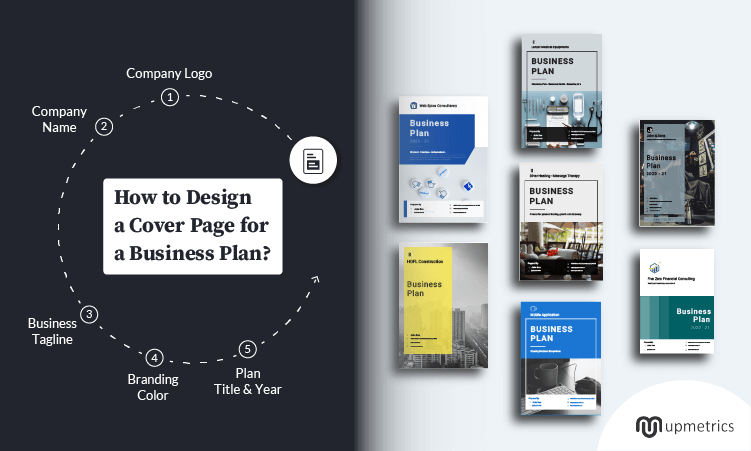
Many entrepreneurs spend hours preparing and writing their business plans. However, do not pay much attention to the cover page. This is a big mistake.
The business plan cover page can create a strong first impact. It sets the platform for how investors or readers will engage with your document.
In this article, we will understand the importance of a cover page and how you can design one yourself.
What is a Business Plan Cover Page & Why is it Necessary to Design it?
The cover page is an integral part of the business plan. It is the first page of your business plan that highlights the key information of your company like a company logo, company name, address, and other key information.
By looking at the business plan cover page, a banker or investor can get a quick idea about the purpose of the presented document.
Your business plan cover should be neat, clean, attractive, and professional enough to draw your reader’s attention.
Whether you are writing a business plan, marketing plan, or business proposal , the cover page is an essential part of all.
Need a captivating cover page for your business plan?
Make compelling business plans in minutes with Upmetrics
Plans starting from $7/month

What to include in the Business Plan Cover Page?
There is no specific rule about what to include and what not on your cover page. But we have prepared some essential information that you should not miss including in it.
1. Company Logo
Your company logo will be the first and most essential section that will draw your reader’s attention immediately, so you must include your company logo on your cover page.
A neat-clean, high-quality logo should be used to make your business plan cover page look like a professional cover page. It should be placed at the top of your business plan cover page.
Placing the logo on the business plan cover page sets a strong brand association that focuses a reader’s attention throughout the document.
2. Company Name
The second most important section of the cover page after the company logo is your company name. You will always want your reader to remember your company name through the document reading process.
Your company name font should be readably bold and should be the largest font on the page so that it stands out from the rest of the information on the business plan cover page.
3. Business Tagline or Motto
A business tagline is a short catchy marketing slogan that is usually written with a company name or brand and is also sometimes used to indicate key features of your business. Some businesses use a tagline to show what they do and how they are different from the competition.
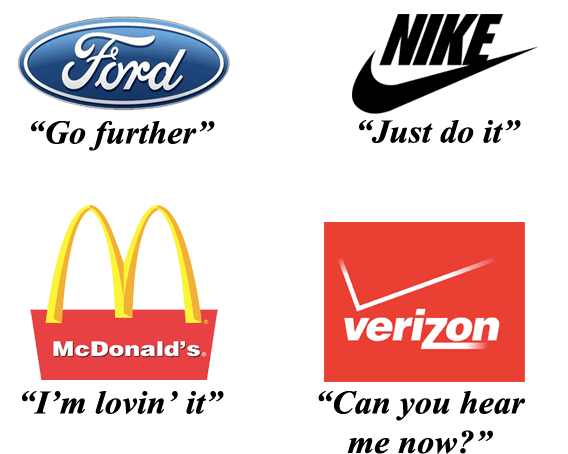
If you want your readers to understand your business, then a tagline plays a crucial role. Usually, a memorable tagline can excite an investor or reader that they will take a special interest while reading your business plan.
4. Branding Color
Brand color is most important in establishing trust and confidence in your customers. Your brand color will speak more than you can think about your business. Also, the right use of colors can increase your brand value by creating a strong visual identity in the industry.
Most successful companies have a strong association with their logos and brand colors. Their colors always tend to reflect their branding, even when they don’t include any text on them.
Brand color can help in establishing trust and familiarity by evoking the right emotions in your reader’s brains and sending the right message to them. Also, your brand color should be integrated into your business plan everywhere, like titles, subtitles, features, images, etc to make your business plan template more attractive.
5. Plan Title and Plan Year
The plan title will give a clear idea about what the presented document is about, whether it is a business plan, marketing plan, business expansion plan, recovery plan, or anything else.
The plan title is the notable feature of the cover page and should be in large font size. Immediately, the reader should know the purpose of the presented document.
There is no rule about which should be of the largest font size, “Company Name” or “Plan Title” as both have their benefits. It is the owner’s choice to decide what they want to highlight on the cover page for their document.
Also, readers will want to learn about what is the business plan creation time or what will be the execution time for the presented document. Thus it is important to specify the plan year on your cover page.
It should be written relatively in a smaller size and frequently below the plan title.
6. Prepared By
The “Prepared By” section is used to specify who is presenting the document and it should be the name of the company CEO, President, Owner, or sometimes another key person.
This information will help the reader to know about the key person in the company and whom they should contact in the case for more information.
7. Contact Information
Contact information contains the information reader can use to contact the person specified in the “Prepared By” section. This information includes the company’s physical address, phone number, email address, and company website .
Contact information should always be on the business plan cover page. It lets the reader learn who is presenting the document and how to contact that person.
8. Confidentiality Statement
While it is not required, you may want to include a confidentiality statement on the cover page. Or just state “Confidential” to let the reader know that this document is confidential and not directed to share with others without the owner’s consent.
The confidentiality statement on your cover page will look like this:
Example of Confidentiality Statement
Tips to make a cover page remarkable.
Now, that you know what to include in a cover page of the business plan, let’s see how to make it memorable:
Check the formatting
Before presenting or submitting your business plan to the readers, make sure the formatting (spacing, fonts, size, color) everything is consistent. This will increase the readability and help your audience to understand the things you want to deliver.
Keep it all simple
Keep your cover page for a business plan free from any clutters. The design should be classy and elegant. It should sync with the goals of your business. Ensure consistency by using the same brand color for both your business’ branding and cover page.
Review—Re-review
Double-check the cover page for any typos or grammatical errors. The better option is to have another person review it. This way, he/she will find the mistakes that you might be missing out on.
How to Design a Business Plan Cover Page?
Upmetrics gives you a beautifully designed business plan cover page template with no work on your side. Industry experts recommend our cover pages. Thus, you can trust us for your cover page without any doubts.
You can use a cover page theme that suits the personality of you and your business. Upmetrics comes with professionally designed cover pages that immediately transform the reader’s plain business plan reading experience into an interesting opening.
Upmetrics provides a feature where you can control which information and section you want to highlight on the cover page. Also, you can remove any section that you feel is not necessary for your cover page.
We also allow you to upload your own custom cover page design, so you can personalize your business plan with the cover page of your choice. So, wait no more, and start designing your cover page!
Upmetrics Business Plan Cover Page Examples
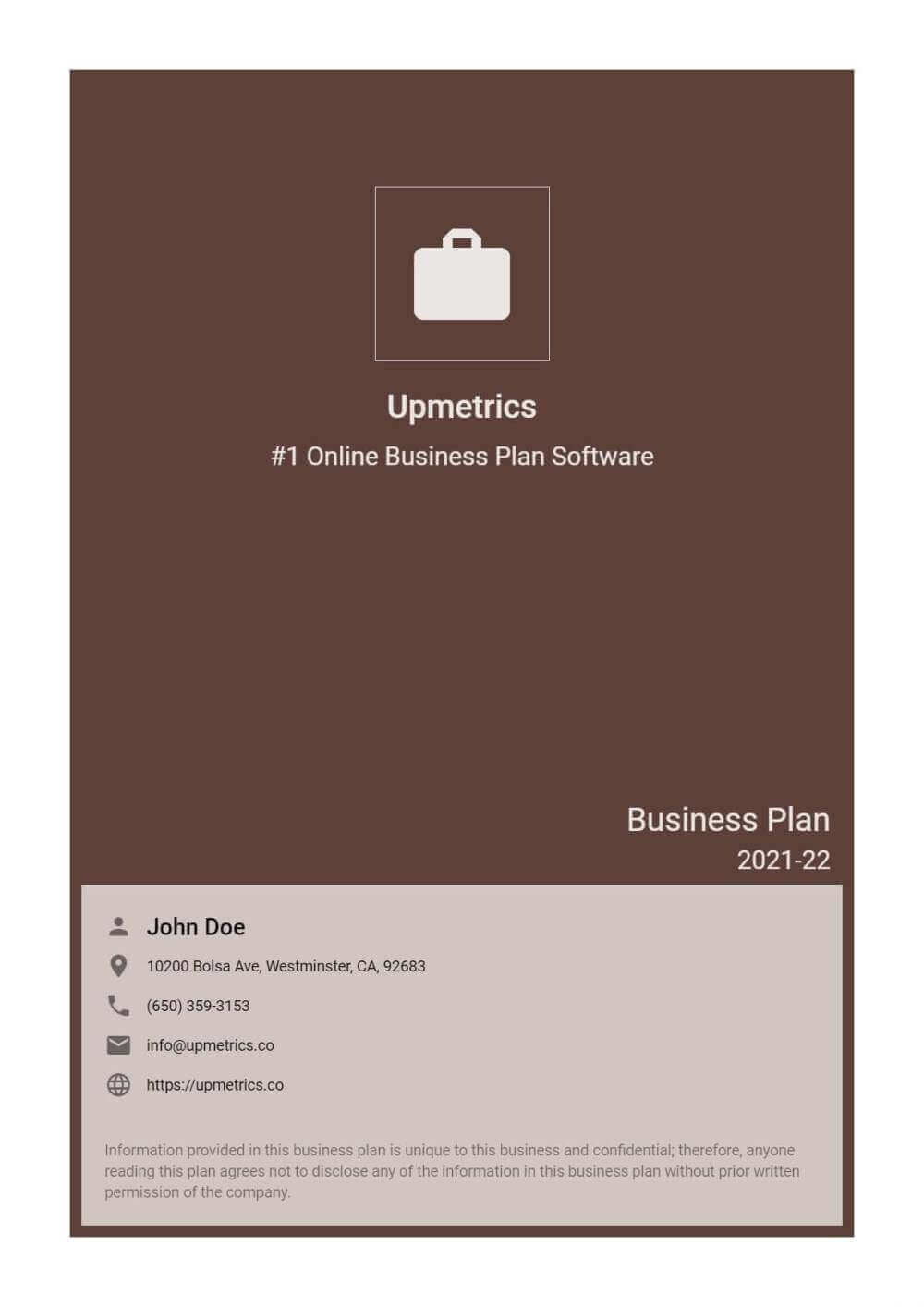
Build your Business Plan Faster
with step-by-step Guidance & AI Assistance.
Frequently Asked Questions
Does a business proposal have a cover page.
Yes, a business proposal includes a cover page. The cover page is the first impression of your proposal and should include key information, such as the title, company name, date, and logo.
The cover page can make your business proposal look more professional as it sets the tone for the proposal.
What three aspects must be included in the cover page?
The three main things to include in a cover page of a business plan are:
- Clear title: It should be focused on the main topic of the plan & business idea.
- Contact information: Include the name of your company and the ways to contact you.
- Date: Readers would want to know the execution time and the timeline of the business plan.
What is the best format for a cover page?
A business plan cover page is the first thing that your potential investors will see. So, the best format for a cover page is to keep it simple & clean so that it draws your audience’s attention to read the whole business plan.
About the Author
Upmetrics Team
Upmetrics is the #1 business planning software that helps entrepreneurs and business owners create investment-ready business plans using AI. We regularly share business planning insights on our blog. Check out the Upmetrics blog for such interesting reads. Read more
Reach Your Goals with Accurate Planning
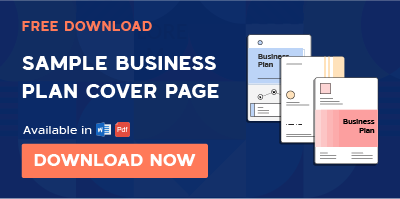
- Bookkeeping
- Accounts Receivable
- Accounts Payable
- Catch-Up Bookkeeping
- Financial Reporting
- Fractional Controllership
- Local Bookkeeping
- Industry Bookkeeping
- [email protected]
How to Design a Cover Page for Your Business Plan
- 26th Nov, 2023
If you're starting a new business or growing an existing one, it's critical to have a successful business plan to guide your decisions.

- Starting a Business
Why? A good plan helps you understand your business expenses and cash flow, and it can lay out your goals and track milestones along the way. It's also important if you're applying for a loan or approaching potential investors who may be interested in your future business.
That means when you're writing your business plan, you have one chance to make a good first impression and catch your reader's attention. It takes a lot of research and planning, but after you've finished the hard work of compiling the contents of your plan, you're still not done. Your business plan's cover page may seem like an afterthought, but it shouldn't be. As they say, never judge a book by its cover, but that's precisely what happens when it comes to business plan cover pages.
A glimpse at the cover page can be enough for someone to decide if they want to pay attention to your business or ignore it. So, before you distribute your business plan, design a cover that stands out and entices interested parties to find out more about your company.
Helpful resource: How to Write Your First Business Plan
What is a business plan cover page?
Think of the cover page (also called a title page) as a welcome mat that leads to your full business plan. It's meant to be simple and highlight the legal information of your business like a company logo, company name, address, contact details, and other key information.
The quality and appearance of the cover page may influence the perception of the material that follows in your plan—and the credibility of your business. If you want to spark the interest of prospective investors or lenders, you need to make sure that it's professional, informative, and easy to read.
What is the purpose of a business plan cover page?
The main purpose of any business plan cover page is to inform and enhance your report. Your cover page should communicate a little about the business plan itself and provide the necessary information for a reader to contact you about the business you're spotlighting.
Keep the cover page concise and focus only on the introductory basics. There's no need to get into the weeds here. Instead, save those details about how your business will operate for the executive summary, which underlines the most crucial pieces of your plan, such as your short-term and long-term goals.
What should you include on a business plan cover page?
There are no hard-and-fast rules about what to show on your business plan cover page. But there are a few standard elements you should consider adding. Once you know what information you want to use, you just have to arrange it.
1. Document title
Often, the title of these documents is merely "Business Plan." But you can also customize it with "Five-Year Business Plan" or "Business Acquisition Plan" if you want to outline more explicit goals of your business plan.
Use a clear, bold font to increase readability, like Times New Roman, Garamond, or Arial. Avoid script lettering as it doesn't come across as professional and may be challenging to read.
2. Business name
Add your company name below the title of the document. Use the same font of the title, but increase the font size slightly, so it stands out. Your company name is a significant part of the cover page, so use sharp, bold text that's big enough to read clearly. Also, center your company name a few spaces below the title to continue a clean and consistent appearance.
3. Contact information
Below your company name, include a physical address, phone number, email, website, and other details about your business. You can also add a section titled "prepared by" to list your name and credentials, as well as the names of partners or collaborators, so readers know where to direct their inquiries.
To keep consistent formatting, center this information on the page. You can use a smaller font size than you used for your company name and title, as long as the information is clearly visible and legible.
4. Date of completion
Under your company's contact information, include the month and year you completed your business plan. Use the same font size as your address and contact information, and center the text for consistency.
5. Company logo
Your logo is the foundation of your brand identity. It can draw interest and pique the curiosity of your audience. If you have a high-resolution thumbnail of your company's logo, add and center it at the top of the page. The logo should be large enough that readers can easily see details, but not so big that it's a distraction from the rest of the content.

6. Business tagline
Some businesses use a tagline to show what they do and how they're different from the competition. Think Nike's "Just Do It" or Dollar Shave Club's "Shave Time. Shave Money."
If you have a tagline, add it to your cover page under your company logo so readers understand straight away what you do or how you do it. A memorable tagline can excite an investor so that they'll take a special interest while evaluating your business plan.
7. Confidentiality statement
At the bottom of your cover page, add a brief confidentiality statement to protect your business's intellectual property or sensitive information. This may prevent others from disclosing your business plan without your permission.
For this section, use a slightly smaller font size, but try to make sure the text is still visible. Here's an example of a typical confidentiality statement:
"This document contains confidential, proprietary information created by (your company's name). It is issued exclusively for informational purposes and should not be reproduced without the consent of (your company's name)."
Business plan cover page templates
Looking to create a standout cover page? There are dozens of professionally-designed business plan templates, including cover pages, available online. You can download and customize these in a matter of minutes.
If you need help getting started, try one of these:
- Microsoft Word
- Business in a Box
- MS Office Templates
You might even be able to adapt one of Canva's proposal templates to suit your needs.
How to make your business plan cover page stand out
A cover page that's messy or unprofessional in any way can create negative preconceptions in your reader's minds before they even look at your business plan.
Set yourself up for success with a cover page that stands out by following these best practices:
Use consistent formatting
Inconsistent formatting can turn a stable document into chaos. Try to stay consistent when using styles and line spacing. Make sure your fonts are complementary, and don't select too many—that could be overwhelming.
Proofread it
Because your cover is the first page of a business plan, it's important to ensure there are zero spelling typos or mistakes within your content. Carefully proofread your document before distributing the final draft and ask someone else to read your work. Having a second set of eyes can smooth out any rough spots and save you potential embarrassment.
Show your brand's personality
The design elements (color scheme, font type, images) you use can create a memorable, bold statement for your cover page that'll make a positive impression on your audience. Still, do keep it professional. Coordinate the colors with your company's logo or brand, and be sure the elements don't distract from the important details on the cover page.
How Accracy can help
While we can't design a beautiful business plan cover page for you, we can help you out with the contents of that plan. Bench is America's largest professional bookkeeping service for small businesses. We can handle your bookkeeping and tax filing for you while you focus on starting and running your business. Even if you're pre-revenue , you need a solid bookkeeping setup—plus, reliable bookkeeping can give you the numbers you need to prove to investors that you're a good bet.
Even if you aren't using your business plan to seek funding, including your financial projections offers major benefits. By looking into the future of your business, you can make plans for growth and set realistic goals to reach along the way. Get started with our guide to financial forecasting .
Make a great first impression
Although your business plan cover page has a big job to do, it's meant to be simple and straightforward. With just a few business details, like your company name, logo, and contact information, the cover page is your first opportunity to stand out and persuade readers that you're worth the investment.
New Customer Offer
We are offering free 1 Month Basic Bookkeeping to all new customers so you can experience Accracy's seemless and professional services.
* No Debit/Credit Card Required
Need help with bookkeeping.
- Operations 166
- Tax Tips 192
- Bookkeeping 56
- Starting a Business 53
- Accounting 133
Recent Post

C Corp vs. LLC: Which Is Better for Early-Stage Entrepreneurs?
Although C corps and LLCs have certain similarities, their unique features offer very different benefits for your business.
.png)
What is an IOLTA Account & 5 Mistakes to Avoid
Mismanaging IOLTA can carry stiff penalties, even leading to disbarment. Here's how to prevent that from happening.

Form 1099-K: Why You Need It and Where to Find It
If your small business processes lots of debit or credit card payments, you might receive something called a 1099-K in the mail at the end of January. What exactly is 1099-K? And what should you do with it?
Ready to grow your business?

How to Create a Business Plan Cover Page
We’ve all heard the adage that you shouldn’t judge a book by its cover. However, the truth is that people DO judge books by their covers – especially busy investors with stacks of unsolicited business plans on their desks.
These investors want an easy way to decide which business plans to pay attention to and which ones to ignore ; often, a quick glance at the cover is enough to make up one’s mind. Here are the things to consider when you create your business plan’s cover page (and you can see an example toward the bottom of this post).
Information to Include on Your Business Plan Cover Page
We recommend including only the essentials so that your reader can quickly scan and absorb the information. Here are the elements we typically include on a business plan’s cover:
- The company logo .
- A short, memorable tagline that reveals what kind of business is described in the plan.
- The words “Business Plan” so that it is clear what kind of document this is.
- The current month and year.
- The name and title of the company’s primary contact for investors (usually the founder/CEO).
- The company name and mailing address.
- Contact information that will allow an investor to reach you quickly and easily, such as a phone number, email address, website, twitter handle, etc.
- A copyright notice and a one- or two-sentence confidentiality statement.
Design Considerations for Your Business Plan Cover Page
Your design should be clean and professional:
- In general, we recommend the “less is more” approach, so you should avoid cluttering the cover with a slew of photos or other graphics.
- Be consistent with alignment. Unless you have an excellent reason for mixing up your alignment, don’t. For example, if you choose to left-justify some things, then left-justify all elements on your business plan’s cover page.
- Don’t use more than two fonts. I like a sans-serif font (think Arial) for the largest text and a serif font (think Times New Roman) for everything else, but that’s a matter of personal taste.
- Keep your color scheme very simple. If you use more than one color (aside from black), use a color scheme generator to select colors that go well together. Alternatively, consider sticking with only the colors in your logo if you already have one designed.
- If you choose to use an image, try putting it in the top 40% of the page, leaving enough room so that the other information doesn’t look cluttered. Also, the image should “bleed” to the edges of the page (this looks great in PDF format but will leave a white border if you print a hard copy).
You’ll most likely be distributing your plan in multiple formats – probably as a PDF file and in hard copy. Make sure the graphics look great in every format you use. If your logo looks pixelated, you should get a higher resolution image from your logo designer . The latest versions of Microsoft Office products — Word, Excel, and PowerPoint — have a “Save as Adobe PDF” option.
Here’s an example of a simple, straight-forward design we often use:
Final Thoughts About Your Business Plan’s Cover Page
Be sure to proofread everything carefully. A typo on your cover page won’t make a great first impression!
Finally, remember that these aren’t rigid rules. In fact, some of our consultants have personal styles that vary greatly from the advice provided above, as you can see in the business plan examples shown on our website. However, we all do our best to ensure that our cover pages look neat and professional so that they stand out from the crowd and have a better chance of being read. In the end, that’s the most important outcome.
Akira Hirai
Akira is the Founder & CEO of Cayenne Consulting. He has over 30 years of experience both as an entrepreneur and helping other entrepreneurs succeed. Akira earned his BA in Engineering Sciences from Harvard University. View details.
- September 11, 2019
Home » Blog » Business Plans » How to Create a Business Plan Cover Page
- previous post: How to Start a Restaurant
- next post: How to Start a Bank
- Business Plan Preparation
- Pitch Deck (Investor Presentation) Design
- Financial Forecasting and Analysis
- Business Plan Makeover
- Business Plan and Financial Model Reviews
- Franchise Business Plans
- Immigration Visa Business Plans
- Business Model Design
- Business Valuation Services
- Market & Competitor Research
- International Business Consulting
- Business Certification Services
- Business Turnaround Consulting
- Chicago, IL
- Los Angeles, CA
- New York, NY
- Orange County, CA
- Philadelphia, PA
- Phoenix & Tucson, AZ
- Pittsburgh, PA
- Portland, OR
- Salt Lake City, UT
- San Francisco, CA
- Seattle, WA
- Sydney, Australia
- Tampa & Orlando, FL
- Washington, DC
- Cannabis, Hemp & CBD
- Consumer Products, Services & Retail
- Education & E-Learning
- Financial Services
- Healthcare, Biotech & Medical Devices
- Manufacturing, Industrial & Aerospace
- Media & Entertainment
- Mobile, Software & Internet
- Non-Profits
- Professional & Business Services
- Real Estate
- Restaurant, Lounge & Bar
- Semiconductor, Hardware & Networking
- Telecommunications
- Consumer Products & Services
- Hardware & Networking
- Healthcare & Medical
- International
- Manufacturing & Industrial
- Not-for-Profit
- Professional Services & B2B
- Real Estate & Hospitality
- Software, Internet & Mobile
- Consulting Team
- Senior Advisors
- In the Media
- Startup Resources
- Cannabis & CBD Business Plan Samples
- Internet, Mobile & Software Business Plan Samples
- Media & Entertainment Business Plan Samples
- Healthcare Business Plan Samples
- Real Estate Business Plan Samples
- Restaurant Business Plan Samples
- Telecommunication Business Plan Samples
- Business Plan Templates
- Entrepreneur’s Library
- High Tech Startup Valuation Estimator
- Capital Comparison Table
- Why Business Plans Don’t Get Funded
- What Kills Startups?
- Options for Creating Your Business Plan
- Request Quote
- Contact Information
- Send Feedback
How to Build a Detailed Business Plan That Stands Out [Free Template]
Updated: March 29, 2022
Published: March 11, 2022
While starting a company may seem easier now than ever before, entrepreneurs have an uphill battle from the moment they start a business. And without a clear, actionable business plan for selling, marketing, finances, and operations, you're almost destined to face significant challenges.

This is why crafting a business plan is an essential step in the entrepreneurial process.
In this post, we'll walk you through the process of filling out your business plan template, like this free, editable version :

Download a free, editable one-page business plan template.
We know that when looking at a blank page on a laptop screen, the idea of writing your business plan can seem impossible. However, it's a mandatory step to take if you want to turn your business dreams into a reality.

That's why we've crafted a business plan template for you to download and use to build your new company. You can download it here for free . It contains prompts for all of the essential parts of a business plan, all of which are elaborated on, below.
This way, you'll be able to show them how organized and well-thought-out your business idea is, and provide them with answers to whatever questions they may have.
.webp)
Free Business Plan Template
The essential document for starting a business -- custom built for your needs.
- Outline your idea.
- Pitch to investors.
- Secure funding.
- Get to work!
Download Free
All fields are required.
You're all set!
Click this link to access this resource at any time.
Building a Successful Business Plan
In the next section, we'll cover the components of a business plan , such as an executive summary and company description. But before we get to that, let's talk about key elements that should serve as building blocks for your plan.
For some entrepreneurs, the thought of writing a business plan sounds like a chore — a necessary means to an end. But that's a bad take.
A solid business plan is a blueprint for success . It's key to securing financing, presenting your business, outlining your financial projections, and turning that nugget of a business idea into a reality.
At the core, your business plan should answer two questions: why your business and why now?
Investors want to know why your business is entering the market, i.e. what problem it's solving and how it's different from what's currently out there. They also want to know why now is the right time for your type of product or service.
At a minimum, your plan should:
- Be more realistic than idealistic: Too often, business plans focus too much on how things could be instead of how they are. While having a vision is important, your plan needs to be rooted in research and data.
- Legitimize your business idea : If an idea fails on paper, it's a signal to go back to the drawing board. In doing so, you avoid losing precious time or money chasing an unrealistic idea.
- Position your business for funding: To get your business off the ground, chances are you'll need financial backing. Even with a solid business idea, investors, lenders, and banks still need convincing. An effective business plan will outline how much money you need, where it's going, what targets you will hit, and how you plan to repay any debts.
- Lay the foundation: Investors focus on risk – if anything looks shaky, it could be a dealbreaker. Ideally, your business plan will lay down the foundation for how you'll operate your business — from operational needs to financial projections and goals.
- Communicate your needs: It's nearly impossible to communicate your needs if you don't know what they are first. Of course, a business’ needs are always changing — but your plan should give you a well-rounded view of how your business will work in the short and long term.
So back to the question of why and why now – consider three things:
- Your industry – How does your product or service fit within your industry? Are you targeting a specific niche? Where do you see the industry going in the next five to 10 years?
- Your target audience – Who are you targeting? What challenges are they facing? How will your product or service help them in their daily lives?
- Your unique selling proposition (USP) – What sets you apart from your competitors? Is it your product/service features? Your company values? Price?
Once you know the answers to these questions, you'll be equipped to answer the question: why your business and why now.
How to Build a Business Plan
- Executive Summary
- Company and Business Description
- Product and Services Line
- Market Analysis
- Marketing Plan
- Legal Notes
- Financial Considerations
Featured Resource: Free Business Plan Template
1. cover page.
Your business plan should be prefaced with an eye-catching cover page. This means including a high-resolution image of your company logo, followed by your company's name, address, and phone number.
Since this business plan will likely change hands and be seen by multiple investors, you should also provide your own name, role in the business, and email address on the cover page.
At the bottom of this page, you can also add a confidentiality statement to protect against the disclosure of your business details.
The statement can read as follows: " This document contains confidential and proprietary information created by [your company name]. When receiving this document, you agree to keep its content confidential and may only reproduce and/or share it with express written permission of [your company name] ."
Remember to keep your cover page simple and concise — and save the important details for other sections.
Why it matters: First impressions are everything, and a clean cover page is the first step in the right direction.
Example of a Cover Page

2. Executive Summary
The executive summary of your business plan provides a one- to two-page overview of your business and highlights the most crucial pieces of your plan, such as your short-term and long-term goals.
The executive summary is essentially a boiled-down version of your entire business plan, so remember to keep this section to the point and filled only with essential information.
Typically, this brief section includes:
- A mission statement.
- The company's history and leadership model.
- An overview of competitive advantage(s).
- Financial projections.
- Company goals.
- An ask from potential investors.
Why it matters: The executive summary is known as the make-or-break section of a business plan. It influences whether investors turn the page or not — so effectively summarizing your business and the problem it hopes to solve is a must.
Think of the Summary as a written elevator pitch (with more detail). While your business plan provides the nitty-gritty details, your Summary describes — in a compelling but matter-of-fact language — the highlights of your plan. If it's too vague, complicated, or fuzzy, you may need to scrap it and start again.
Example of an Executive Summary Introduction
"The future looks bright for North Side Chicago, particularly the Rock Hill Neighborhood. A number of high-end commercial and residential developments are well on their way, along with two new condo developments in nearby neighborhoods.
While the completion of these developments will increase the population within the neighborhood and stimulate the economy, the area lacks an upscale restaurant where residents and visitors can enjoy fine food and drink. Jay Street Lounge and Restaurant will provide such a place."
3. Company & Business Description
In this section, provide a more thorough description of what your company is and why it exists.

The bulk of the writing in this section should be about your company's purpose – covering what the business will be selling, identifying the target market, and laying out a path to success.
In this portion of your business plan, you can also elaborate on your company's:
- Mission statement
- Core values
- Team and organizational structure
Why it matters: Investors look for great structures and teams in addition to great ideas. This section gives an overview of your businesses' ethos. It's the perfect opportunity to set your business apart from the competition — such as your team's expertise, your unique work culture, and your competitive advantage.
Example of a Values/Mission Statement
"Jay Street Lounge and Restaurant will be the go-to place for people to get a drink or bite in an elegant, upscale atmosphere. The mission is to be North Side's leading restaurant, with the best tasting food and the highest quality service."
3. Product & Services Line
Here's where you'll cover the makeup of your business's product and/or services line. You should provide each product or service's name, its purpose, and a description of how it works (if appropriate). If you own any patents, copyrights, or trademarks, it's essential to include this info too.
Next, add some color to your sales strategy by outlining your pricing model and mark-up amounts.
If you're selling tangible products, you should also explain production and costs, and how you expect these factors to change as you scale.
Why it matters: This section contains the real meat of your business plan. It sets the stage for the problem you hope to solve, your solution, and how your said solution fits in the market.
There's no one-size-fits-all formula for this section. For instance, one plan may delve into its ability to market in a more cost-effective way than the competition, whereas another plan focuses on its key products and their unique features and benefits.
Regardless of your angle, it's critical to convey how your offerings will differ from the competition.
Example of a Product/Service Offering
"The menu at Jay Street Lounge and Restaurant will focus on Moroccan cuisine. The stars of the menu (our specialties) are the Moroccan dishes, such as eggplant zaalouk, seafood bastilla, tagine, and chickpea stew. For those who enjoy American dishes, there will also be a variety of options, from burger sliders and flatbread pizza to grilled steak and salads.
The food at Jay Street will have premium pricing to match its upscale atmosphere. During the summer months, the restaurant will have extra seating on the patio where clients can enjoy a special summer menu. We will be open on all days of the week."
4. Market Analysis

It helps to reference your market research documentation in this section, like a Porter's Five Forces Analysis or a SWOT Analysis ( templates for those are available here ). You can also include them in your appendix.
If your company already has buyer personas, you should include them here as well. If not, you can create them right now using the Make My Persona Tool .
Why it matters: Having an awesome product is, well, awesome — but it isn't enough. Just as important, there must be a market for it.
This section allows you to dig deeper into your market, which segments you want to target, and why. The "why" here is important, since targeting the right segment is critical for the success and growth of your business.
It's easy to get lost (or overwhelmed) in a sea of endless data. For your business plan, narrow your focus by answering the following questions:
- What is my market? In other words, who are my customers?
- What segments of the market do I want to target?
- What's the size of my target market?
- Is my market likely to grow?
- How can I increase my market share over time?
Example of a Market Analysis
"Jay Street Lounge and Restaurant will target locals who live and work within the Rock Hill Neighborhood and the greater North Side Chicago area. We will also target the tourists who flock to the many tourist attractions and colleges on the North Side.
We will specifically focus on young to middle-aged adults with an income of $40,000 to $80,000 who are looking for an upscale experience. The general demographics of our target market are women between 20 to 50 years old.
A unique and varied Moroccan-American menu, along with our unique upscale atmosphere, differentiates us from competitors in the area. Jay Street will also set itself apart through its commitment to high-quality food, service, design, and atmosphere."
5. Marketing Plan
Unlike the market analysis section, your marketing plan section should be an explanation of the tactical approach to reaching your aforementioned target audience. List your advertising channels, organic marketing methods, messaging, budget, and any relevant promotional tactics.
If your company has a fully fleshed-out marketing plan, you can attach it in the appendix of your business plan. If not, download this free marketing plan template to outline your strategy.

Free Marketing Plan Template
Outline your company's marketing strategy in one simple, coherent plan.
- Pre-Sectioned Template
- Completely Customizable
- Example Prompts
- Professionally Designed
Why it matters: Marketing is what puts your product in front of your customers. It's not just advertising — it's an investment in your business.
Throwing money into random marketing channels is a haphazard approach, which is why it's essential to do the legwork to create a solid marketing plan.
Here's some good news — by this point, you should have a solid understanding of your target market. Now, it's time to determine how you'll reach them.
Example of a Marketing Plan Overview
"Our marketing strategy will focus on three main initiatives:
- Social media marketing. We will grow and expand our Facebook and Instagram following through targeted social media ads.
- Website initiatives. Our website will attract potential visitors by offering updated menus and a calendar of events.
- Promotional events. Jay Street will have one special theme night per week to attract new clients."
6. Sales Plan
It doesn't matter if your sales department is an office full of business development representatives (BDR) or a dozen stores with your products on their shelves.
The point is: All sales plans are different, so you should clearly outline yours here. Common talking points include your:
- Sales team structure, and why this structure was chosen.
- Sales channels.
- Sales tools, software, and resources.
- Prospecting strategy.
- Sales goals and budget.
Like with your marketing plan, it might make sense to attach your completed sales plan to the appendix of your business plan. You can download a template for building your sales plan here .
Why it matters: Among other things, investors are interested in the scalability of your business — which is why growth strategies are a critical part of your business plan.
Your sales plan should describe your plan to attract customers, retain them (if applicable), and, ultimately, grow your business. Be sure to outline what you plan to do given your existing resources and what results you expect from your work.
Example of a Sales Plan Overview
"The most important goal is to ensure financial success for Jay Street Lounge and Restaurant. We believe we can achieve this by offering excellent food, entertainment, and service to our clients.
We are not a low-cost dining option in the area. Instead, the food will have premium pricing to match its upscale feel. The strategy is to give Jay Street a perception of elegance through its food, entertainment, and excellent service."
7. Legal Notes
Your investors may want to know the legal structure of your business, as that could directly impact the risk of their investments. For example, if you're looking for business partners to engage in a non-corporation or LLC partnership, this means they could be on the line for more than their actual investment.
Because this clarification is often needed, explain if you are and/or plan to become a sole proprietor, partnership, corporation, LLC, or other.
You should also outline the steps you have taken (or will need to take) to operate legally. This includes licenses, permits, registrations, and insurance.
The last thing your investor wants to hear after they've sent you a big chunk of change is that you're operating without proper approval from the local, state, or federal government.
Why it matters: The last thing your investor wants to hear after they've sent you a big chunk of change is that you're operating without proper approval from the local, state, or federal government.
Example of Legal Notes
"Jay Street Lounge and Restaurant is up-to-date on all restaurant licenses and health permits. Our business name and logo are registered trademarks, presenting the possibility of expanding locally."
8. Financial Considerations
Ultimately, investors want to know two things:
- When they will earn their money back.
- When they will start seeing returns on their initial investment.
That said, be clear, calculated, and convincing in this section. It should cover:
- Startup costs.
- Sales forecasts for the next several months/quarters.
- Break-even analysis for time and dollars.
- Projected profit and loss (P&L) statement.
Facts and figures are key here, so be as specific as possible with each line item and projection. In addition, explain the "why" behind each of these sections.
However, keep in mind that information overload is a risk, especially when it comes to data. So, if you have pages upon pages of charts and spreadsheets for this section, distill them into a page or two and include the rest of the sheets in the appendix. This section should only focus on key data points.
Why it matters: One of the most important aspects of becoming "investor ready" is knowing your numbers. More importantly, you need to understand how those numbers will enhance your business.
While it's easy to write a number down on paper, it's more important to understand (and communicate) why you need capital, where it's going, and that your evaluation makes sense.
Example of Financial Projections
"Based on our knowledge and experience in the restaurant industry, we have come up with projections for the business.
Starting with an expenditure of $400,000 in year 1, we forecast sales of $1,500,000 and $2,800,000 for years two and three. We expect to achieve a net profit of 15% by year three."
9. Appendix
A detailed and well-developed business plan can range anywhere from 20 to 50 pages, with some even reaching upward of 80.
In many cases, the appendix is the longest section. Why? Because it includes the supportive materials mentioned in previous sections. To avoid disrupting the flow of the business plan with visuals, charts, and spreadsheets, business owners usually add them in the last section, i.e. the appendix.
Aside from what we've already mentioned – marketing plan, sales plan, department budgets, financial documents – you may also want to attach the following in the appendix:
- Marketing materials
- Market research data
- Licensing documentation
- Branding assets
- Floor plans for your location
- Mockups of your product
- Renderings of your office space or location design
Adding these pieces to the appendix enriches the reader's understanding of your business and proves you've put the work into your business plan without distracting from the main points throughout the plan.
Why it matters: An appendix helps the reader do their due diligence. It contains everything they need to support your business plan.
Keep in mind, however, that an appendix is typically necessary only if you're seeking financing or looking to attract business partners.
Use a Business Plan Template to Get Started
Writing a business plan shouldn't be an insurmountable roadblock to starting a business. Unfortunately, for all too many, it is.
That's why we recommend using our free business plan template. Pre-filled with detailed section prompts for all of the topics in this blog post, we're confident this template will get your business plan started in the right direction.
Editor's note: This post was originally published in June 2017 and has been updated for comprehensiveness.

Don't forget to share this post!
Related articles.
![business plan cover page How to Calculate Your Lead Generation Goals [Free Calculator]](https://www.hubspot.com/hubfs/lead-generation-goal-calculator_5.webp)
How to Calculate Your Lead Generation Goals [Free Calculator]

What Are Direct Costs & How Do They Differ From Indirect Costs?
![business plan cover page How to Write a Business Plan: A Step-by-Step Guide [Examples + Template]](https://53.fs1.hubspotusercontent-na1.net/hubfs/53/how%20to%20write%20a%20business%20plan.jpg)
How to Write a Business Plan: A Step-by-Step Guide [Examples + Template]

9 Handy Business Calculators That’ll Make Your Life Easier
![business plan cover page The Definition of CAC [In Under 100 Words]](https://53.fs1.hubspotusercontent-na1.net/hub/53/file-1053926490-jpg/calculate_CAC_%28blog%29.jpg)
The Definition of CAC [In Under 100 Words]
![business plan cover page How to Calculate the Value of Your Social Media Followers [CALCULATOR]](https://cdn2.hubspot.net/hub/53/file-23155342-png/blog/images/voal-snapshot.png)
How to Calculate the Value of Your Social Media Followers [CALCULATOR]

How to Calculate & Track a Leads Goal That Sales Supports
2 Essential Templates For Starting Your Business
Marketing software that helps you drive revenue, save time and resources, and measure and optimize your investments — all on one easy-to-use platform
Everything You Need to Know About a Business Plan Cover Page
An integral but potentially overlooked part of a business plan is its cover page. Business plans work to secure financial resources and partnerships, while driving a business towards growth and expansion. As such, a business plan aims to create a brand with an established reputation. If done right, a cover page for a business plan acts as a preview and builds a positive impression that will benefit a business in various ways.
What is a Cover Page?
A business plan cover page serves as a one-page introduction to a comprehensive business plan, capturing the main points of an organization. It includes basic company information, similar to a title page, and allows readers to immediately determine a business plan’s purpose with one look.
Purpose of a Cover Page
An effective business plan cover page exhibits an excellent quality, design, and a professional tone that aligns with a business’s goals and ideas. With this, the cover page communicates the essence of a business plan, while also outlining contact information that enables readers to reach out to the business and owners themselves.
New businesses or even reputable organizations may benefit from well-designed and detailed business plan cover pages. The cover page is an essential first impression that pushes readers, and investors alike, to read through the entirety of the business plan. Below summarizes the significance of a business cover page:
- Effectively convey the content of a business plan
- Provide concise and straightforward business details
- List contact details for readers’ reference
- Establish an overarching tone for the business plan
Elements of a Good Business Plan Cover
Here are some key components that good cover pages should include:
Business Plan Title
Cover pages do not exist for business plans only. Cover pages can be used in marketing plans, strategic plans , and other documents. Including a business plan title in the cover page communicates what a document is about, at a glance. A business plan title will boost a business plan’s readability by using clean and striking fonts like Arial. It is best to avoid script font styles, such as Lucida Writing, since they reduce the professional appearance of the business plan.
Company Name
The company name or business name should be the most noticeable element in the cover page. Formatting the company name using bold and large typefaces makes it stand out. This pushes the business name to be stuck in the readers’ minds.
Business Logo
The business logo should be simple but memorable. It is best to match it with the company’s color scheme and include relevant features that refer to the business’s brand identity. The logo is usually placed at the top most part of the business plan cover page.
A tagline or slogan will catch the interest of business plan readers since its focuses on immediately describing a business’s activities and how these differ from their competitors. Take note that this is a discretionary element but a welcome addition to the cover page as signifies a business’s brand, similar to a logo.
Contact Information
The “presented by” or “prepared by” portion of the cover page presents contact information a reader can refer to when reaching out to a business. Contact information may include a business’s phone number, e-mail address, website, or mailing address. Investors know where to direct their queries if the contact information also includes the names of the business owner, partners, and other key contacts. The cover page should place the contact information at the center and make it readable even in a smaller font size.
Completion Date
Placing the month and year of completion in the cover page is vital information that informs the readers when a business plan was accomplished and reported. It is ideal to keep the completion date at the same font size of the contact information to channel consistency in the business plan.
Confidentiality Statement
A business plan confidentiality statement safeguards the business concept from being spread outside of its intended use in the business plan. A short statement or even placing the world “confidential” in the cover page will place emphasis on the business plan’s confidentiality.
Have Questions? Looking To Get Started?
- Your Name *
- Email Address *
- Phone Number
How to Design a Business Plan Cover Page
To design a powerful and creative business plan cover page, it is best to consider the following guidelines:
- Be consistent : The cover page’s formatting should exhibit consistency. The colors, design, and fonts of the cover page should work in harmony to create a good impression and catch readers’ attention. Proofreading further ensures that the cover page will avoid grammatical and spelling errors that may cause a negative impression from a business plan’s readers.
- Less is more: A creative business plan cover page does not entail complicated and intricate graphics. A simple page that neatly and clearly lays out relevant business information creates more impact than complex designs.
- Establish a brand : Since the cover page is a reader’s first look at a business plan, it should communicate a brand’s personality and pique the interest of its readers. There are various applications and techniques to developing a successful business plan cover page. In recent years, entrepreneurs have adopted a growing design platform, Canva , and other applications such as Adobe , to utilize cover page business plan templates or to create cover pages from scratch. Keeping a uniform color scheme helps with building a business’s brand and crafts a strong visual identity that will resonate to its audience. Colors should blend in the cover page instead of taking away the attention from the business plan.
Business Plan Cover Page Examples
Make Your Business Standout with BSBCON
Set your business apart from competitors by crafting a distinctive brand identity with the help of our Business Plan Consultants . Appeal to your target audience and ensure a unique presence in the market by reaching out today.
How can we help you?
Get in touch with us or visit our office

Business Plan Cover Page Template
Make a business business plan cover page using business plan cover page template from Venngage.
- Design style modern
- Colors dark
- Size Letter (8.5 x 11 in)
- File type PNG, PDF, PowerPoint
- Plan business
A business plan cover page template is used to provide a summary of a business plan. The template can be used to provide an overview of the business, the products and services offered, the target market, and the management team. When developing a business plan cover page template, there are several things that need to be addressed. First, business plan cover page templates should provide a brief summary of the business plan. This is typically done with one or two paragraphs that explain the business and its purpose. The template can then explain how the business will meet customer needs and solve any problems that may exist. Also, business plan cover pages should address details such as what business approach the business will use, what type of business it is, and how business goals will be achieved. Business plan cover page templates should also include the business name, logo, contact details, business size, and industry information. This can be done by including headings for these topics in the template. Create a business plan cover page using Venngage’s business plan cover
Read more >
Explore more
Related plans.

- Starting a Business
- Growing a Business
- Small Business Guide
- Business News
- Science & Technology
- Money & Finance
- For Subscribers
- Write for Entrepreneur
- Tips White Papers
- Entrepreneur Store
- United States
- Asia Pacific
- Middle East
- United Kingdom
- South Africa
Copyright © 2024 Entrepreneur Media, LLC All rights reserved. Entrepreneur® and its related marks are registered trademarks of Entrepreneur Media LLC
- Write Your Business Plan | Part 1 Overview Video
- The Basics of Writing a Business Plan
- How to Use Your Business Plan Most Effectively
- 12 Reasons You Need a Business Plan
- The Main Objectives of a Business Plan
- What to Include and Not Include in a Successful Business Plan
- The Top 4 Types of Business Plans
- A Step-by-Step Guide to Presenting Your Business Plan in 10 Slides
- 6 Tips for Making a Winning Business Presentation
- 3 Key Things You Need to Know About Financing Your Business
- 12 Ways to Set Realistic Business Goals and Objectives
- How to Perfectly Pitch Your Business Plan in 10 Minutes
- Write Your Business Plan | Part 2 Overview Video
- How to Fund Your Business Through Friends and Family Loans and Crowdsourcing
- How to Fund Your Business Using Banks and Credit Unions
- How to Fund Your Business With an SBA Loan
- How to Fund Your Business With Bonds and Indirect Funding Sources
- How to Fund Your Business With Venture Capital
- How to Fund Your Business With Angel Investors
- How to Use Your Business Plan to Track Performance
- How to Make Your Business Plan Attractive to Prospective Partners
- Is This Idea Going to Work? How to Assess the Potential of Your Business.
- When to Update Your Business Plan
- Write Your Business Plan | Part 3 Overview Video
- How to Write the Management Team Section to Your Business Plan
- How to Create a Strategic Hiring Plan
- How to Write a Business Plan Executive Summary That Sells Your Idea
- How to Build a Team of Outside Experts for Your Business
- Use This Worksheet to Write a Product Description That Sells
- What Is Your Unique Selling Proposition? Use This Worksheet to Find Your Greatest Strength.
- How to Raise Money With Your Business Plan
- Customers and Investors Don't Want Products. They Want Solutions.
- Write Your Business Plan | Part 4 Overview Video
- 5 Essential Elements of Your Industry Trends Plan
- How to Identify and Research Your Competition
- Who Is Your Ideal Customer? 4 Questions to Ask Yourself.
- How to Identify Market Trends in Your Business Plan
- How to Define Your Product and Set Your Prices
- How to Determine the Barriers to Entry for Your Business
- How to Get Customers in Your Store and Drive Traffic to Your Website
- How to Effectively Promote Your Business to Customers and Investors
- Write Your Business Plan | Part 5 Overview Video
- What Equipment and Facilities to Include in Your Business Plan
- How to Write an Income Statement for Your Business Plan
- How to Make a Balance Sheet
- How to Make a Cash Flow Statement
- How to Use Financial Ratios to Understand the Health of Your Business
- How to Write an Operations Plan for Retail and Sales Businesses
- How to Make Realistic Financial Forecasts
- How to Write an Operations Plan for Manufacturers
- What Technology Needs to Include In Your Business Plan
- How to List Personnel and Materials in Your Business Plan
- The Role of Franchising
- The Best Ways to Follow Up on a Buisiness Plan
- The Best Books, Sites, Trade Associations and Resources to Get Your Business Funded and Running
- How to Hire the Right Business Plan Consultant
- Business Plan Lingo and Resources All Entrepreneurs Should Know
- How to Write a Letter of Introduction
- What To Put on the Cover Page of a Business Plan
- How to Format Your Business Plan
- 6 Steps to Getting Your Business Plan In Front of Investors
What To Put on the Cover Page of a Business Plan Use this checklist to ensure you've included all the essential elements in your cover page.
By Eric Butow Oct 27, 2023
Opinions expressed by Entrepreneur contributors are their own.
This is part 6 / 8 of Write Your Business Plan: Section 6: Getting Your Business Plan to Investors series.
You've sent a letter of introduction and the recipients have indicated that they'd like to see your business plan, the next step is to send a cover letter, which is a brief correspondence stating that you are including the business plan that the recipient has acknowledged and asked you to send it over.
The cover letter goes in the email that includes the plan or on top of a hard copy and thanks the recipient for agreeing to look at the plan. Think of it as a brief note to accompany the plan and express gratitude to the recipients for taking a look.
Why is this important? The first thing anyone looking at your business plan will see is the cover page. After that, they may never look at it again.
Related: How to Write a Letter of Introduction
What to Include on a Cover Page
A few cover page components are essential, whether you are using an email or sending a hard copy. You should have your company name, address, phone number, email address, Twitter handle, and other contact information. Other good items to include are the date as a notice that this is a business plan.
- Format this information in a large, black, easily readable font. Above all else, you want a plan reader to know which business this plan is for and how to contact you.
- If you have a striking, well-designed corporate logo, it's also a good idea to include that on the cover page. A corporate slogan, as long as it's not too long, is also a good identifying mark that does something to communicate your strategy as well.
While it's tempting to put all kinds of stuff on the cover page, you should probably resist the urge. Your business concept, the amount you're trying to raise, and other details can go on the inside. The cover page must identify the company. More than that is likely to be too much.
Related: Why You Shouldn't Send Your Business Plan to Investors
More in Write Your Business Plan
Section 1: the foundation of a business plan, section 2: putting your business plan to work, section 3: selling your product and team, section 4: marketing your business plan, section 5: organizing operations and finances, section 6: getting your business plan to investors.
Successfully copied link
How to Write a Business Plan: Step-by-Step Guide + Examples

Noah Parsons
24 min. read
Updated July 29, 2024

Writing a business plan doesn’t have to be complicated.
In this step-by-step guide, you’ll learn how to write a business plan that’s detailed enough to impress bankers and potential investors, while giving you the tools to start, run, and grow a successful business.
- The basics of business planning
If you’re reading this guide, then you already know why you need a business plan .
You understand that planning helps you:
- Raise money
- Grow strategically
- Keep your business on the right track
As you start to write your plan, it’s useful to zoom out and remember what a business plan is .
At its core, a business plan is an overview of the products and services you sell, and the customers that you sell to. It explains your business strategy: how you’re going to build and grow your business, what your marketing strategy is, and who your competitors are.
Most business plans also include financial forecasts for the future. These set sales goals, budget for expenses, and predict profits and cash flow.
A good business plan is much more than just a document that you write once and forget about. It’s also a guide that helps you outline and achieve your goals.
After completing your plan, you can use it as a management tool to track your progress toward your goals. Updating and adjusting your forecasts and budgets as you go is one of the most important steps you can take to run a healthier, smarter business.
We’ll dive into how to use your plan later in this article.
There are many different types of plans , but we’ll go over the most common type here, which includes everything you need for an investor-ready plan. However, if you’re just starting out and are looking for something simpler—I recommend starting with a one-page business plan . It’s faster and easier to create.
It’s also the perfect place to start if you’re just figuring out your idea, or need a simple strategic plan to use inside your business.
Dig deeper : How to write a one-page business plan
Brought to you by
Create a professional business plan
Using ai and step-by-step instructions.
Secure funding
Validate ideas
Build a strategy
- What to include in your business plan
Executive summary
The executive summary is an overview of your business and your plans. It comes first in your plan and is ideally just one to two pages. Most people write it last because it’s a summary of the complete business plan.
Ideally, the executive summary can act as a stand-alone document that covers the highlights of your detailed plan.
In fact, it’s common for investors to ask only for the executive summary when evaluating your business. If they like what they see in the executive summary, they’ll often follow up with a request for a complete plan, a pitch presentation , or more in-depth financial forecasts .
Your executive summary should include:
- A summary of the problem you are solving
- A description of your product or service
- An overview of your target market
- A brief description of your team
- A summary of your financials
- Your funding requirements (if you are raising money)
Dig Deeper: How to write an effective executive summary
Products and services description
This is where you describe exactly what you’re selling, and how it solves a problem for your target market. The best way to organize this part of your plan is to start by describing the problem that exists for your customers. After that, you can describe how you plan to solve that problem with your product or service.
This is usually called a problem and solution statement .
To truly showcase the value of your products and services, you need to craft a compelling narrative around your offerings. How will your product or service transform your customers’ lives or jobs? A strong narrative will draw in your readers.
This is also the part of the business plan to discuss any competitive advantages you may have, like specific intellectual property or patents that protect your product. If you have any initial sales, contracts, or other evidence that your product or service is likely to sell, include that information as well. It will show that your idea has traction , which can help convince readers that your plan has a high chance of success.
Market analysis
Your target market is a description of the type of people that you plan to sell to. You might even have multiple target markets, depending on your business.
A market analysis is the part of your plan where you bring together all of the information you know about your target market. Basically, it’s a thorough description of who your customers are and why they need what you’re selling. You’ll also include information about the growth of your market and your industry .
Try to be as specific as possible when you describe your market.
Include information such as age, income level, and location—these are what’s called “demographics.” If you can, also describe your market’s interests and habits as they relate to your business—these are “psychographics.”
Related: Target market examples
Essentially, you want to include any knowledge you have about your customers that is relevant to how your product or service is right for them. With a solid target market, it will be easier to create a sales and marketing plan that will reach your customers. That’s because you know who they are, what they like to do, and the best ways to reach them.
Next, provide any additional information you have about your market.
What is the size of your market ? Is the market growing or shrinking? Ideally, you’ll want to demonstrate that your market is growing over time, and also explain how your business is positioned to take advantage of any expected changes in your industry.
Dig Deeper: Learn how to write a market analysis
Competitive analysis
Part of defining your business opportunity is determining what your competitive advantage is. To do this effectively, you need to know as much about your competitors as your target customers.
Every business has some form of competition. If you don’t think you have competitors, then explore what alternatives there are in the market for your product or service.
For example: In the early years of cars, their main competition was horses. For social media, the early competition was reading books, watching TV, and talking on the phone.
A good competitive analysis fully lays out the competitive landscape and then explains how your business is different. Maybe your products are better made, or cheaper, or your customer service is superior. Maybe your competitive advantage is your location – a wide variety of factors can ultimately give you an advantage.
Dig Deeper: How to write a competitive analysis for your business plan
Marketing and sales plan
The marketing and sales plan covers how you will position your product or service in the market, the marketing channels and messaging you will use, and your sales tactics.
The best place to start with a marketing plan is with a positioning statement .
This explains how your business fits into the overall market, and how you will explain the advantages of your product or service to customers. You’ll use the information from your competitive analysis to help you with your positioning.
For example: You might position your company as the premium, most expensive but the highest quality option in the market. Or your positioning might focus on being locally owned and that shoppers support the local economy by buying your products.
Once you understand your positioning, you’ll bring this together with the information about your target market to create your marketing strategy .
This is how you plan to communicate your message to potential customers. Depending on who your customers are and how they purchase products like yours, you might use many different strategies, from social media advertising to creating a podcast. Your marketing plan is all about how your customers discover who you are and why they should consider your products and services.
While your marketing plan is about reaching your customers—your sales plan will describe the actual sales process once a customer has decided that they’re interested in what you have to offer.
If your business requires salespeople and a long sales process, describe that in this section. If your customers can “self-serve” and just make purchases quickly on your website, describe that process.
A good sales plan picks up where your marketing plan leaves off. The marketing plan brings customers in the door and the sales plan is how you close the deal.
Together, these specific plans paint a picture of how you will connect with your target audience, and how you will turn them into paying customers.
Dig deeper: What to include in your sales and marketing plan
Business operations
The operations section describes the necessary requirements for your business to run smoothly. It’s where you talk about how your business works and what day-to-day operations look like.
Depending on how your business is structured, your operations plan may include elements of the business like:
- Supply chain management
- Manufacturing processes
- Equipment and technology
- Distribution
Some businesses distribute their products and reach their customers through large retailers like Amazon.com, Walmart, Target, and grocery store chains.
These businesses should review how this part of their business works. The plan should discuss the logistics and costs of getting products onto store shelves and any potential hurdles the business may have to overcome.
If your business is much simpler than this, that’s OK. This section of your business plan can be either extremely short or more detailed, depending on the type of business you are building.
For businesses selling services, such as physical therapy or online software, you can use this section to describe the technology you’ll leverage, what goes into your service, and who you will partner with to deliver your services.
Dig Deeper: Learn how to write the operations chapter of your plan
Key milestones and metrics
Although it’s not required to complete your business plan, mapping out key business milestones and the metrics can be incredibly useful for measuring your success.
Good milestones clearly lay out the parameters of the task and set expectations for their execution. You’ll want to include:
- A description of each task
- The proposed due date
- Who is responsible for each task
If you have a budget, you can include projected costs to hit each milestone. You don’t need extensive project planning in this section—just list key milestones you want to hit and when you plan to hit them. This is your overall business roadmap.
Possible milestones might be:
- Website launch date
- Store or office opening date
- First significant sales
- Break even date
- Business licenses and approvals
You should also discuss the key numbers you will track to determine your success. Some common metrics worth tracking include:
- Conversion rates
- Customer acquisition costs
- Profit per customer
- Repeat purchases
It’s perfectly fine to start with just a few metrics and grow the number you are tracking over time. You also may find that some metrics simply aren’t relevant to your business and can narrow down what you’re tracking.
Dig Deeper: How to use milestones in your business plan
Organization and management team
Investors don’t just look for great ideas—they want to find great teams. Use this chapter to describe your current team and who you need to hire . You should also provide a quick overview of your location and history if you’re already up and running.
Briefly highlight the relevant experiences of each key team member in the company. It’s important to make the case for why yours is the right team to turn an idea into a reality.
Do they have the right industry experience and background? Have members of the team had entrepreneurial successes before?
If you still need to hire key team members, that’s OK. Just note those gaps in this section.
Your company overview should also include a summary of your company’s current business structure . The most common business structures include:
- Sole proprietor
- Partnership
Be sure to provide an overview of how the business is owned as well. Does each business partner own an equal portion of the business? How is ownership divided?
Potential lenders and investors will want to know the structure of the business before they will consider a loan or investment.
Dig Deeper: How to write about your company structure and team
Financial plan
Last, but certainly not least, is your financial plan chapter.
Entrepreneurs often find this section the most daunting. But, business financials for most startups are less complicated than you think, and a business degree is certainly not required to build a solid financial forecast.
A typical financial forecast in a business plan includes the following:
- Sales forecast : An estimate of the sales expected over a given period. You’ll break down your forecast into the key revenue streams that you expect to have.
- Expense budget : Your planned spending such as personnel costs , marketing expenses, and taxes.
- Profit & Loss : Brings together your sales and expenses and helps you calculate planned profits.
- Cash Flow : Shows how cash moves into and out of your business. It can predict how much cash you’ll have on hand at any given point in the future.
- Balance Sheet : A list of the assets, liabilities, and equity in your company. In short, it provides an overview of the financial health of your business.
A strong business plan will include a description of assumptions about the future, and potential risks that could impact the financial plan. Including those will be especially important if you’re writing a business plan to pursue a loan or other investment.
Dig Deeper: How to create financial forecasts and budgets
This is the place for additional data, charts, or other information that supports your plan.
Including an appendix can significantly enhance the credibility of your plan by showing readers that you’ve thoroughly considered the details of your business idea, and are backing your ideas up with solid data.
Just remember that the information in the appendix is meant to be supplementary. Your business plan should stand on its own, even if the reader skips this section.
Dig Deeper : What to include in your business plan appendix
Optional: Business plan cover page
Adding a business plan cover page can make your plan, and by extension your business, seem more professional in the eyes of potential investors, lenders, and partners. It serves as the introduction to your document and provides necessary contact information for stakeholders to reference.
Your cover page should be simple and include:
- Company logo
- Business name
- Value proposition (optional)
- Business plan title
- Completion and/or update date
- Address and contact information
- Confidentiality statement
Just remember, the cover page is optional. If you decide to include it, keep it very simple and only spend a short amount of time putting it together.
Dig Deeper: How to create a business plan cover page
How to use AI to help write your business plan
Generative AI tools such as ChatGPT can speed up the business plan writing process and help you think through concepts like market segmentation and competition. These tools are especially useful for taking ideas that you provide and converting them into polished text for your business plan.
The best way to use AI for your business plan is to leverage it as a collaborator , not a replacement for human creative thinking and ingenuity.
AI can come up with lots of ideas and act as a brainstorming partner. It’s up to you to filter through those ideas and figure out which ones are realistic enough to resonate with your customers.
There are pros and cons of using AI to help with your business plan . So, spend some time understanding how it can be most helpful before just outsourcing the job to AI.
Learn more: 10 AI prompts you need to write a business plan
- Writing tips and strategies
To help streamline the business plan writing process, here are a few tips and key questions to answer to make sure you get the most out of your plan and avoid common mistakes .
Determine why you are writing a business plan
Knowing why you are writing a business plan will determine your approach to your planning project.
For example: If you are writing a business plan for yourself, or just to use inside your own business , you can probably skip the section about your team and organizational structure.
If you’re raising money, you’ll want to spend more time explaining why you’re looking to raise the funds and exactly how you will use them.
Regardless of how you intend to use your business plan , think about why you are writing and what you’re trying to get out of the process before you begin.
Keep things concise
Probably the most important tip is to keep your business plan short and simple. There are no prizes for long business plans . The longer your plan is, the less likely people are to read it.
So focus on trimming things down to the essentials your readers need to know. Skip the extended, wordy descriptions and instead focus on creating a plan that is easy to read —using bullets and short sentences whenever possible.
Have someone review your business plan
Writing a business plan in a vacuum is never a good idea. Sometimes it’s helpful to zoom out and check if your plan makes sense to someone else. You also want to make sure that it’s easy to read and understand.
Don’t wait until your plan is “done” to get a second look. Start sharing your plan early, and find out from readers what questions your plan leaves unanswered. This early review cycle will help you spot shortcomings in your plan and address them quickly, rather than finding out about them right before you present your plan to a lender or investor.
If you need a more detailed review, you may want to explore hiring a professional plan writer to thoroughly examine it.
Use a free business plan template and business plan examples to get started
Knowing what information to include in a business plan is sometimes not quite enough. If you’re struggling to get started or need additional guidance, it may be worth using a business plan template.
There are plenty of great options available (we’ve rounded up our 8 favorites to streamline your search).
But, if you’re looking for a free downloadable business plan template , you can get one right now; download the template used by more than 1 million businesses.
Or, if you just want to see what a completed business plan looks like, check out our library of over 550 free business plan examples .
We even have a growing list of industry business planning guides with tips for what to focus on depending on your business type.
Common pitfalls and how to avoid them
It’s easy to make mistakes when you’re writing your business plan. Some entrepreneurs get sucked into the writing and research process, and don’t focus enough on actually getting their business started.
Here are a few common mistakes and how to avoid them:
Not talking to your customers : This is one of the most common mistakes. It’s easy to assume that your product or service is something that people want. Before you invest too much in your business and too much in the planning process, make sure you talk to your prospective customers and have a good understanding of their needs.
- Overly optimistic sales and profit forecasts: By nature, entrepreneurs are optimistic about the future. But it’s good to temper that optimism a little when you’re planning, and make sure your forecasts are grounded in reality.
- Spending too much time planning: Yes, planning is crucial. But you also need to get out and talk to customers, build prototypes of your product and figure out if there’s a market for your idea. Make sure to balance planning with building.
- Not revising the plan: Planning is useful, but nothing ever goes exactly as planned. As you learn more about what’s working and what’s not—revise your plan, your budgets, and your revenue forecast. Doing so will provide a more realistic picture of where your business is going, and what your financial needs will be moving forward.
- Not using the plan to manage your business: A good business plan is a management tool. Don’t just write it and put it on the shelf to collect dust – use it to track your progress and help you reach your goals.
- Presenting your business plan
The planning process forces you to think through every aspect of your business and answer questions that you may not have thought of. That’s the real benefit of writing a business plan – the knowledge you gain about your business that you may not have been able to discover otherwise.
With all of this knowledge, you’re well prepared to convert your business plan into a pitch presentation to present your ideas.
A pitch presentation is a summary of your plan, just hitting the highlights and key points. It’s the best way to present your business plan to investors and team members.
Dig Deeper: Learn what key slides should be included in your pitch deck
Use your business plan to manage your business
One of the biggest benefits of planning is that it gives you a tool to manage your business better. With a revenue forecast, expense budget, and projected cash flow, you know your targets and where you are headed.
And yet, nothing ever goes exactly as planned – it’s the nature of business.
That’s where using your plan as a management tool comes in. The key to leveraging it for your business is to review it periodically and compare your forecasts and projections to your actual results.
Start by setting up a regular time to review the plan – a monthly review is a good starting point. During this review, answer questions like:
- Did you meet your sales goals?
- Is spending following your budget?
- Has anything gone differently than what you expected?
Now that you see whether you’re meeting your goals or are off track, you can make adjustments and set new targets.
Maybe you’re exceeding your sales goals and should set new, more aggressive goals. In that case, maybe you should also explore more spending or hiring more employees.
Or maybe expenses are rising faster than you projected. If that’s the case, you would need to look at where you can cut costs.
A plan, and a method for comparing your plan to your actual results , is the tool you need to steer your business toward success.
Learn More: How to run a regular plan review
How to write a business plan FAQ
What is a business plan?
A document that describes your business , the products and services you sell, and the customers that you sell to. It explains your business strategy, how you’re going to build and grow your business, what your marketing strategy is, and who your competitors are.
What are the benefits of a business plan?
A business plan helps you understand where you want to go with your business and what it will take to get there. It reduces your overall risk, helps you uncover your business’s potential, attracts investors, and identifies areas for growth.
Having a business plan ultimately makes you more confident as a business owner and more likely to succeed for a longer period of time.
What are the 7 steps of a business plan?
The seven steps to writing a business plan include:
- Write a brief executive summary
- Describe your products and services.
- Conduct market research and compile data into a cohesive market analysis.
- Describe your marketing and sales strategy.
- Outline your organizational structure and management team.
- Develop financial projections for sales, revenue, and cash flow.
- Add any additional documents to your appendix.
What are the 5 most common business plan mistakes?
There are plenty of mistakes that can be made when writing a business plan. However, these are the 5 most common that you should do your best to avoid:
- 1. Not taking the planning process seriously.
- Having unrealistic financial projections or incomplete financial information.
- Inconsistent information or simple mistakes.
- Failing to establish a sound business model.
- Not having a defined purpose for your business plan.
What questions should be answered in a business plan?
Writing a business plan is all about asking yourself questions about your business and being able to answer them through the planning process. You’ll likely be asking dozens and dozens of questions for each section of your plan.
However, these are the key questions you should ask and answer with your business plan:
- How will your business make money?
- Is there a need for your product or service?
- Who are your customers?
- How are you different from the competition?
- How will you reach your customers?
- How will you measure success?
How long should a business plan be?
The length of your business plan fully depends on what you intend to do with it. From the SBA and traditional lender point of view, a business plan needs to be whatever length necessary to fully explain your business. This means that you prove the viability of your business, show that you understand the market, and have a detailed strategy in place.
If you intend to use your business plan for internal management purposes, you don’t necessarily need a full 25-50 page business plan. Instead, you can start with a one-page plan to get all of the necessary information in place.
What are the different types of business plans?
While all business plans cover similar categories, the style and function fully depend on how you intend to use your plan. Here are a few common business plan types worth considering.
Traditional business plan: The tried-and-true traditional business plan is a formal document meant to be used when applying for funding or pitching to investors. This type of business plan follows the outline above and can be anywhere from 10-50 pages depending on the amount of detail included, the complexity of your business, and what you include in your appendix.
Business model canvas: The business model canvas is a one-page template designed to demystify the business planning process. It removes the need for a traditional, copy-heavy business plan, in favor of a single-page outline that can help you and outside parties better explore your business idea.
One-page business plan: This format is a simplified version of the traditional plan that focuses on the core aspects of your business. You’ll typically stick with bullet points and single sentences. It’s most useful for those exploring ideas, needing to validate their business model, or who need an internal plan to help them run and manage their business.
Lean Plan: The Lean Plan is less of a specific document type and more of a methodology. It takes the simplicity and styling of the one-page business plan and turns it into a process for you to continuously plan, test, review, refine, and take action based on performance. It’s faster, keeps your plan concise, and ensures that your plan is always up-to-date.
What’s the difference between a business plan and a strategic plan?
A business plan covers the “who” and “what” of your business. It explains what your business is doing right now and how it functions. The strategic plan explores long-term goals and explains “how” the business will get there. It encourages you to look more intently toward the future and how you will achieve your vision.
However, when approached correctly, your business plan can actually function as a strategic plan as well. If kept lean, you can define your business, outline strategic steps, and track ongoing operations all with a single plan.
Noah is the COO at Palo Alto Software, makers of the online business plan app LivePlan. He started his career at Yahoo! and then helped start the user review site Epinions.com. From there he started a software distribution business in the UK before coming to Palo Alto Software to run the marketing and product teams.

Table of Contents
- Use AI to help write your plan
- Common planning mistakes
- Manage with your business plan
Related Articles

5 Min. Read
How To Write a Business Plan for a Life Coaching Business + Free Example

3 Min. Read
What to Include in Your Business Plan Appendix

7 Min. Read
How to Write a Bakery Business Plan + Sample

1 Min. Read
How to Calculate Return on Investment (ROI)
The LivePlan Newsletter
Become a smarter, more strategic entrepreneur.
Your first monthly newsetter will be delivered soon..
Unsubscribe anytime. Privacy policy .

The quickest way to turn a business idea into a business plan
Fill-in-the-blanks and automatic financials make it easy.
No thanks, I prefer writing 40-page documents.

Discover the world’s #1 plan building software

Business Plan Cover Page Tips To Get an Investor’s Attention
Written by Dave Lavinsky

Below are the five keys to creating a formal business plan cover page.
To see what to include in the other sections of your plan, reference the best business plan template .
Be sure to include the following elements to create a great business plan cover page:
1. Company Name
First and foremost, your Company’s name should be included on the business plan cover page. This should be the most prominent feature of the cover page, and as such, is traditionally in the largest font setting. Immediately, the reader should know the name of your company.
2. Company Logo and Color Scheme
The best business plan covers are those that look like they are of professional quality. This can be accomplished by including a high-quality image of the company logo and the font type and color scheme for the company’s marketing materials. Like a book cover, a business plan cover page is intended to draw the reader’s attention immediately. Plans with an unattractive cover page can fall victim to incorrect preconceived notions.
Below is a sample of the professionally designed covers included in Growthink’s Ultimate Business Plan Template .
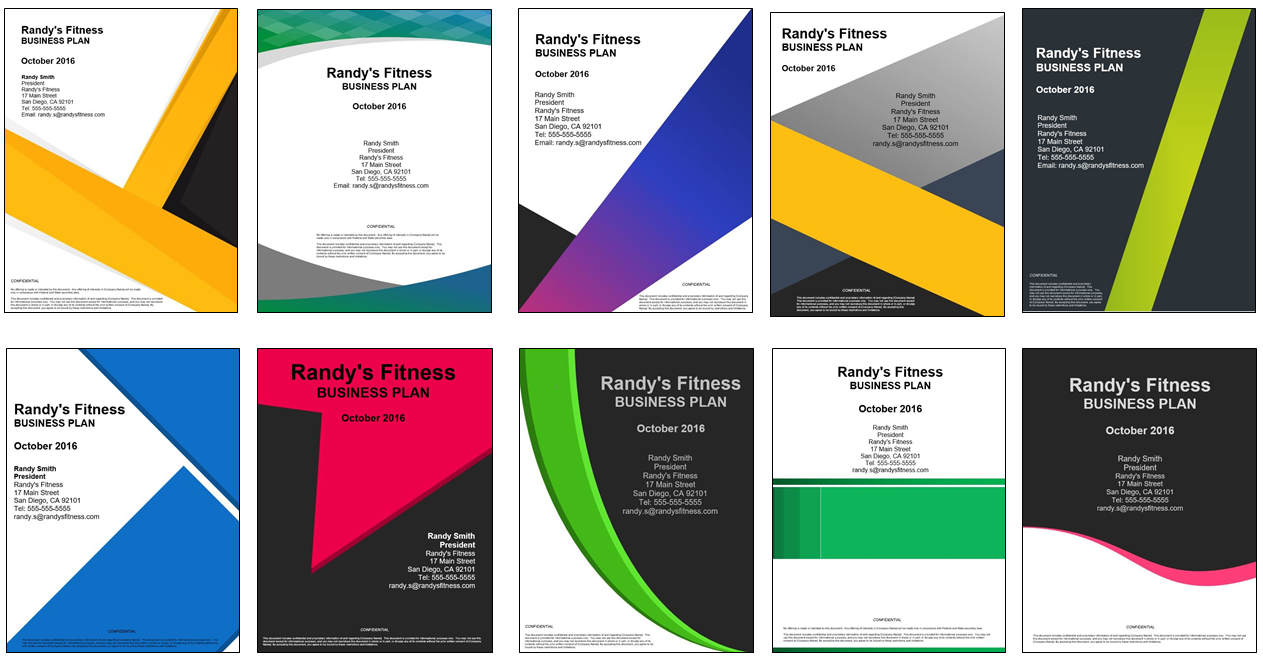
3. Title and Date
When was this plan written? Readers need to know, so include the date (month and year are enough).
And what is it? The cover page should state if this is a Business Plan, Executive Summary, or Financial Projections. So, at this point, your business plan cover page may read as follows:
John’s Plumbing, Inc. Business Plan March 2021
Note that the title and date should be featured less prominently than your company name.
4. Less is More
Your business plan executive summary will summarize the contents of the plan. There is no need for the cover page to do so, as well. It is also inadvisable to create a business plan cover that is so graphically busy that the information is difficult to discern. Simple, clean, and powerful are the three goals of a strong business plan cover page.
5. CEO/Owner/Key Contact Information
Who should the reader contact if they wish to know more information? The name and contact information for the CEO, President, Owner, or another key contact should not be located at the end of the document. It should be on the first page, letting the reader know who is presenting the document.
6. Confidentiality Statement
While it is not essential, you may want to include a Confidentiality Statement on your cover, such as the following:
This document includes confidential and proprietary information of and regarding [Company Name]. This document is provided for informational purposes only. You may not use this document except for informational purposes, and you may not reproduce this document in whole or in part or divulge any of its contents without the prior written consent of [Company Name]. By accepting this document, you agree to be bound by these restrictions and limitations.
Suggested Resources:
Download Growthink’s Ultimate Business Plan Template here that not only has ten pre-built and professionally designed cover pages but quickly guides you through creating your entire business plan and financial model.
Your business plan title page is critical since it’s the first thing readers will see, and it will give them an immediate impression as to whether you are professional or not. As such, the page is one of the critical components of a business plan . As part of your initial business plan outline , you should think about how you want others to perceive your business. Not only should this perception be established throughout your plan but be sure to do so on your business plan cover page.
Many people ask about business plan cover letters to accompany their plans.
Most plans are emailed to investors or lenders nowadays. As such, business plan cover letters are often not needed. Instead, in the body of your email, you can include text such as the following: “Attached please find my business plan. I am available to discuss this at your convenience. I look forward to hearing from you.” Such an email will typically suffice if you seek a bank loan, VC funding, or funding from angel investors .
However, if you’d like a more formal cover letter, reference our sample business plan cover letter here .
To answer any additional questions you might have regarding your plan, see our business plan help page or download our small business plan template pdf to get started today.
The World’s #1 Business Plan Template
Would you like to know the quickest and easiest way to create a winning business plan?
And how to use it to raise funding, improve your strategy, or both?
Well, we’ve developed the ultimate business plan template to help you do this. Simply click below to learn more.

Other Helpful Business Plan Articles & Templates

- TemplateLab
- Art & Media
- Cover Page Templates
55 Amazing Cover Page Templates (Word, PowerPoint + PSD)
In the academic and professional arenas, you often need to prepare reports or projects which need a cover page template. The cover page is the very first thing that the reader would see. Therefore, the cover page for project should be well-made.
Table of Contents
- 1 Title Page Templates
- 2 When do you use a cover page?
- 3 The important elements of a cover page template
- 4 Report Cover Page Templates
- 5.1 Academic cover page
- 5.2 Business cover page
- 5.3 Report cover page
- 6 Cover Sheet Examples
- 7 How to make a cover page?
- 8 Cover Page For Project
- 9 How to create a title page?
Title Page Templates
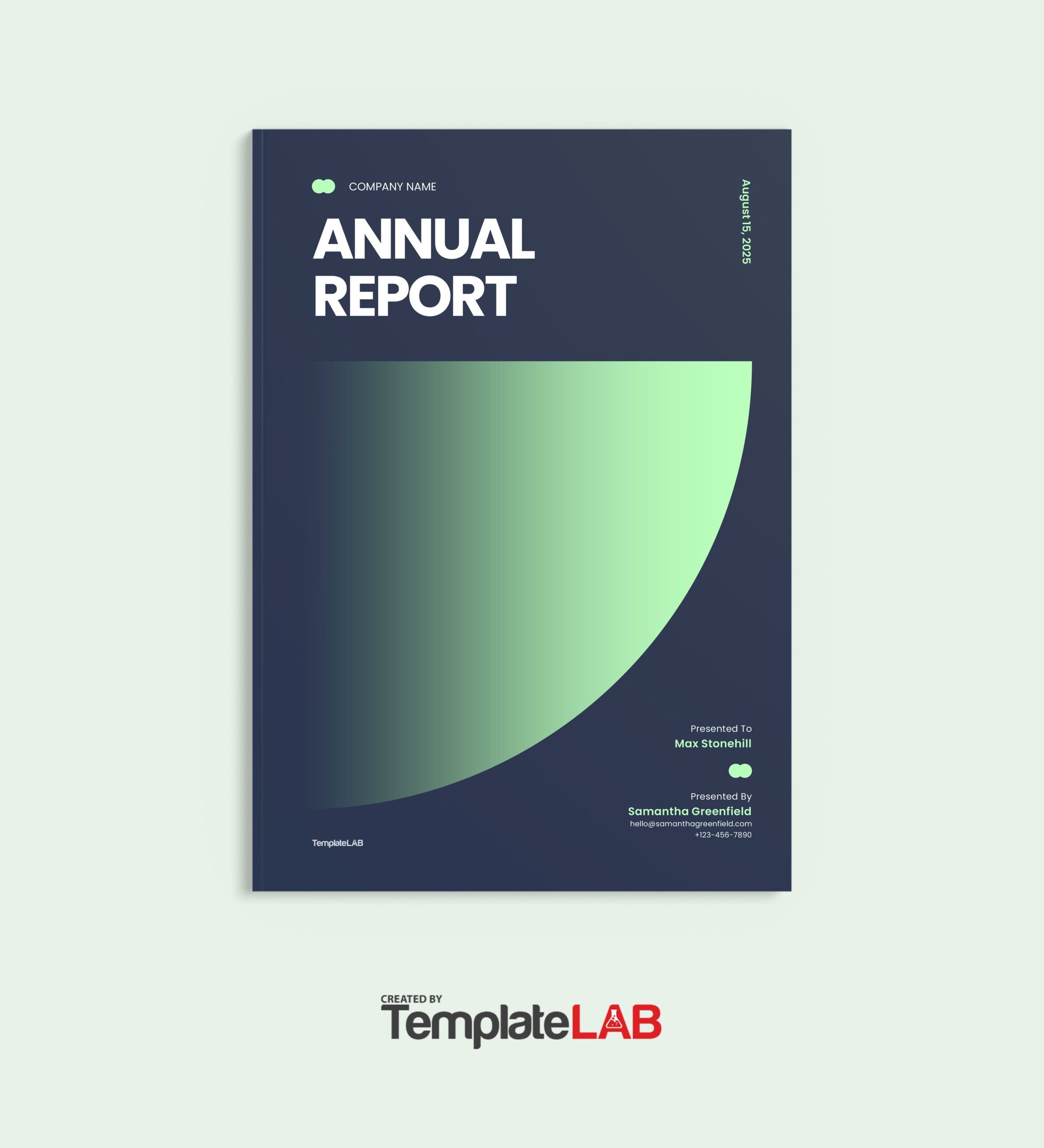
When do you use a cover page?
A cover page template is also known as a title page template, and you can use it in different kinds of projects such as:
- academic essays
- business plans
- professional reports
- white papers
However, this template differs from cover sheets and cover letters. A cover sheet is a type of document sent with fax which provides the recipient with additional information. On the other hand, a cover letter is usually attached to a resume when you apply for a job .
The important elements of a cover page template
Before making your portfolio cover page, you should know what elements to include in it. Simple as this page may seem, there are some things which you need to incorporate into it. These are:
- The title or subtitle of the document
- The name of the author
- The title of the author
- The cover image or cover photo
- The completion or submission date
- The description of the document
Also, the color spread, style, and layout of the report cover page should blend together with the rest of the document seamlessly. Also, you should follow any other requirements set by your instructor or the recipient of the document.
Report Cover Page Templates
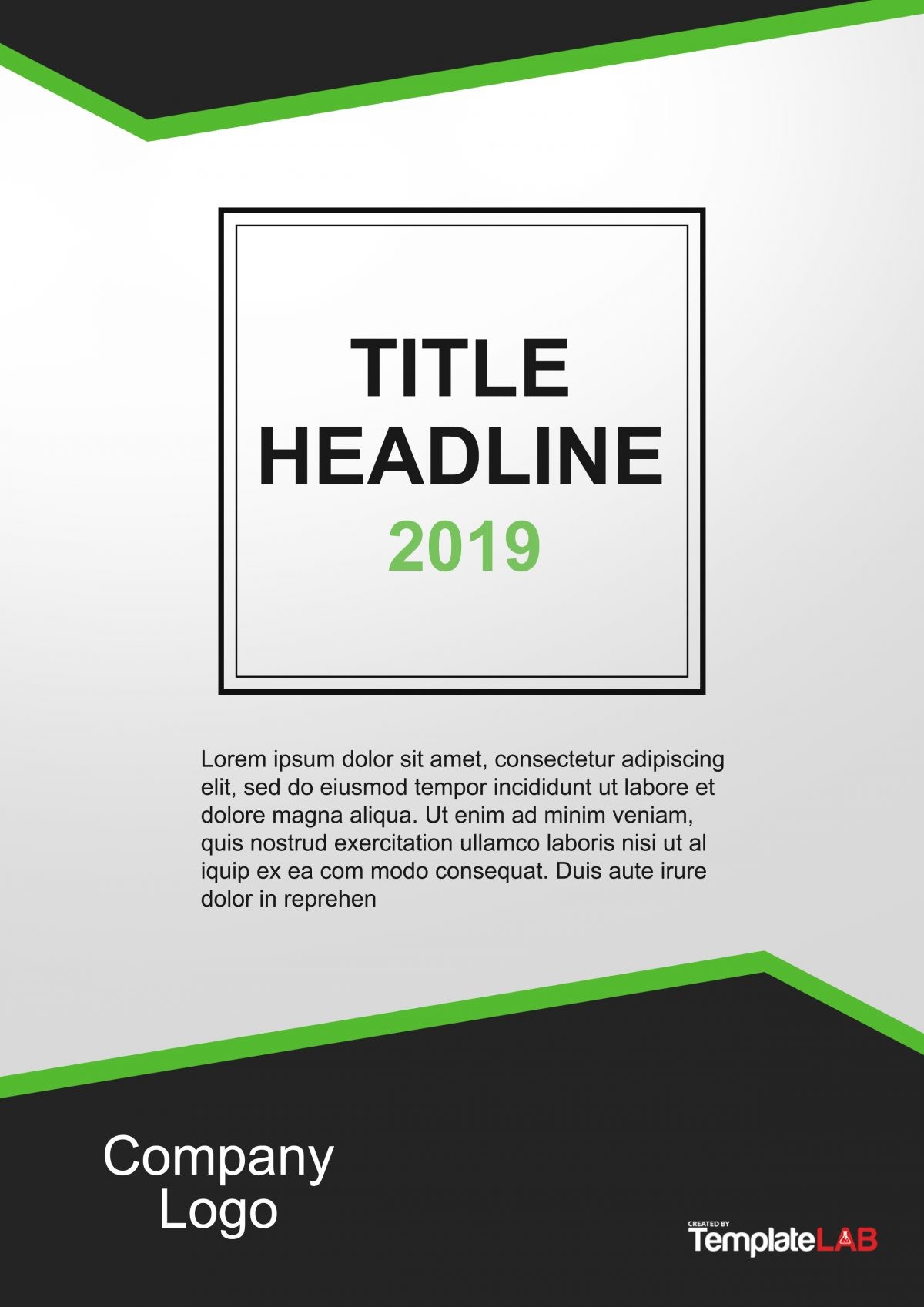
Common types of cover page templates
When you look at different cover sheet examples online, you’ll discover that there are different types to choose from. Here are the most common ones:
Academic cover page
In the academic world, making a cover page template requires some rules. In fact, following these guidelines is just as essential as the content within the paper or the document. Also, the cover page should follow the proper format depending on the style set by the instructor. The most common format styles of academic cover pages are:
- American Psychological Association or APA This format is now in its 6th Edition, and it’s commonly used in the field of social sciences. When following this format style, the cover page should include a title, a running header, the name of the author, the name of the institution, and any other notes the author wants to include.
- Modern Language Association or MLA This format is now in its 8th Edition, and it’s commonly used in the fields of humanities and arts. Normally, this format doesn’t require a cover page, but some instructors still ask for it. If you’re required to make a cover page, follow the guidelines set by your instructor .
- Chicago Manual of Style or CMS This format is now in its 16th Edition, and it’s also commonly used in the fields of humanities and arts. In such a format, you might need to make a standalone cover page, or you may add the title on the first page of your document.
Business cover page
This style is very common in the corporate world, and its design would depend on the nature of the company or the organization. Some cover pages require formality and professionalism while others may need more flair and creativity. For instance, some technical reports only show figures and facts which means that you would only need to use a conservative design for the template. But marketing and business plans might need more imagery and color to attract more readers.
Report cover page
There are different styles you can use when making a template for a cover page template for a report. You would use a different style when making a template for a marketing report compared to when making a template for a business proposal . Use your professionalism or creativity as you see fit to impress your target audience.
Cover Sheet Examples

How to make a cover page?
When you’re thinking about preparing a cover page template, remember that it’s all about the first impression. Your document might have a lot of good content, but without a well-made report cover page, your target audience might not even read it. There are many crucial things to keep in mind when creating your report’s cover page.
The cover page is at the very start of a document. From the beginning, the purpose of this page is to provide the reader with a good idea of what your document is all about. You communicate this information by including all the relevant information on this page. Here are some helpful steps to follow when making a cover page for the project in Microsoft Word:
- First, open a new document in Microsoft Word.
- Click on the Insert tab to find the drop-down menu for cover page templates. From there, you can choose which template you’d like to use for your project.
- When you click on a template, it will appear as the first page of your document.
- Click on the fields which have already been pre-formatted and start typing the information. First, the title of your document then the subtitle, the date, your name, and more.
- If you don’t see a style you like in among the available templates, you can also customize one of the pre-formatted templates. For instance, you’d like to change the background image of the template, simply right-click on that picture then select “Click Picture” in the menu.
- If in the middle of making your document, you’d like to change the cover page, you can do this too. Just go back to the first page then choose a new template from the menu. In doing this, the information you’ve added won’t get changed.
- After you’ve added all the information on your cover page, don’t forget to save it in a location that’s easily accessible.
As we’ve said, making a cover page doesn’t require much effort. Even if you want to make your own customized template, you can do this in a matter of steps and in very quick time. The pre-formatted templates available in Microsoft Word will save you a lot of time and effort. However, using such a template would mean that you can’t make your own personality and style shine through. Here are some steps to follow if you plan to design your own portfolio cover page:
- Choose one of the pre-formatted templates from the Insert tab then start editing the template. Change the colors, font styles, and all the other elements in the template.
- You can get stock-free images online and use those for your cover page. Move the elements around and see which arrangement is the most aesthetically appealing.
- When you’re happy with how you cover page, save your document to preserve your customized design.
No matter how you choose to make your cover page, make sure to add all of the important elements which we have discussed in the previous section.
Cover Page For Project

How to create a title page?
Title pages are simple and easy to make. However, you need to follow some specific guidelines when making them. You can download our title page template if it fits into the style you’re instructed to follow. Since making such a template isn’t complicated, you can also make it yourself. Just follow these steps:
- Space the title of the document about a third down the page. If your document has a long title or it has a colon somewhere in it, you can use two lines for the title.
- Make use of “title case capitalization” wherein you use a capital letter at the beginning of the important words such as the verbs, nouns, adjectives, and adverbs.
- Add your name as the author of the document right below the title. Use your complete name and start with your first name, middle initial, then your surname. If more than one person wrote the document, include all of the full names.
- Add the name of your institution, organization or university. This will tell the readers where you performed most of your research. If several authors from different institutions wrote the document, add the name of the institution right below the name of the author/s.
- Now it’s time to format your template. Your title page should be double-spaced. To do this, highlight the text and choose the double space option in the line spacing drop-down menu.
- Your title should have a horizontal center alignment.
- Then add a running header which appears at the top of the page and continues throughout the document. But the header isn’t the title of the document, just a few keywords or about 50 characters.
- The next thing to add is the page number which appears at the upper right-hand corner of the cover page and all the other pages in the document.
More Templates

Magazine Cover Templates

Binder Cover Templates
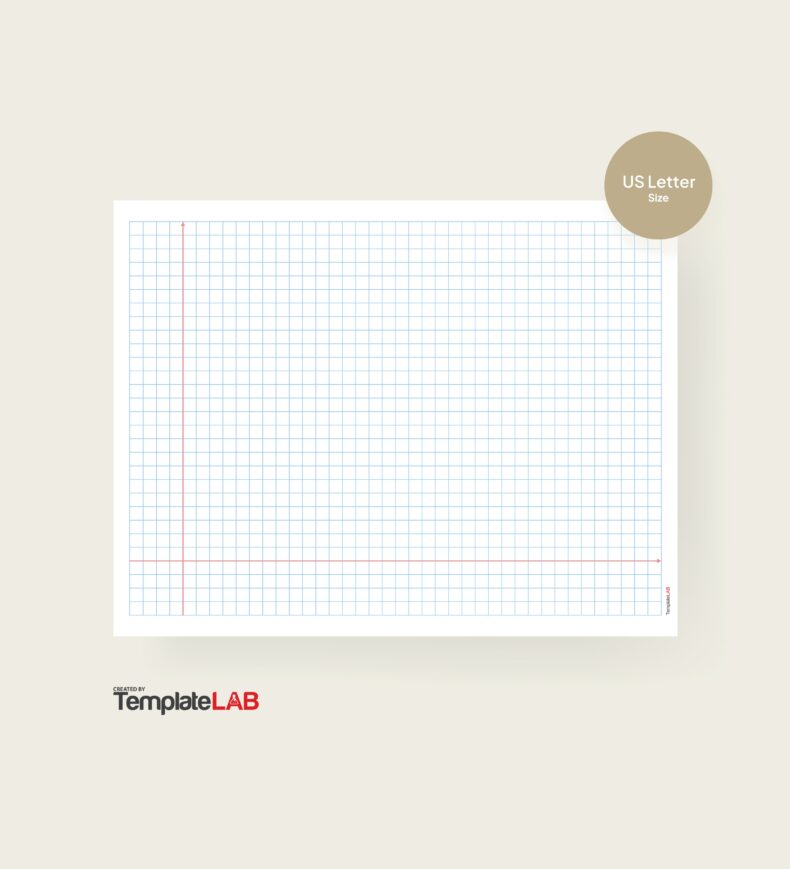
Graph Paper Templates
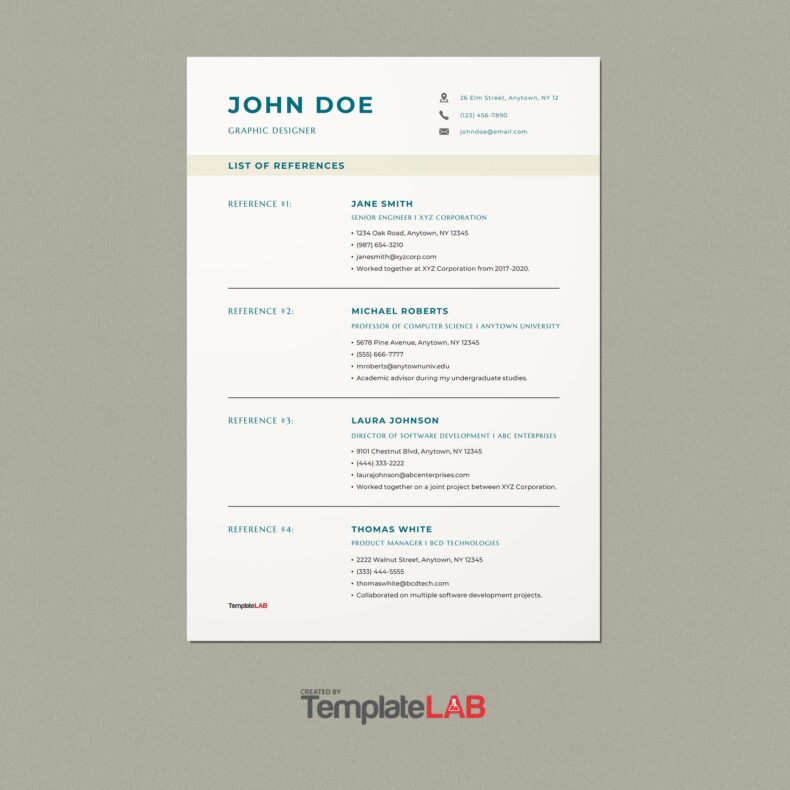
Reference Page Templates
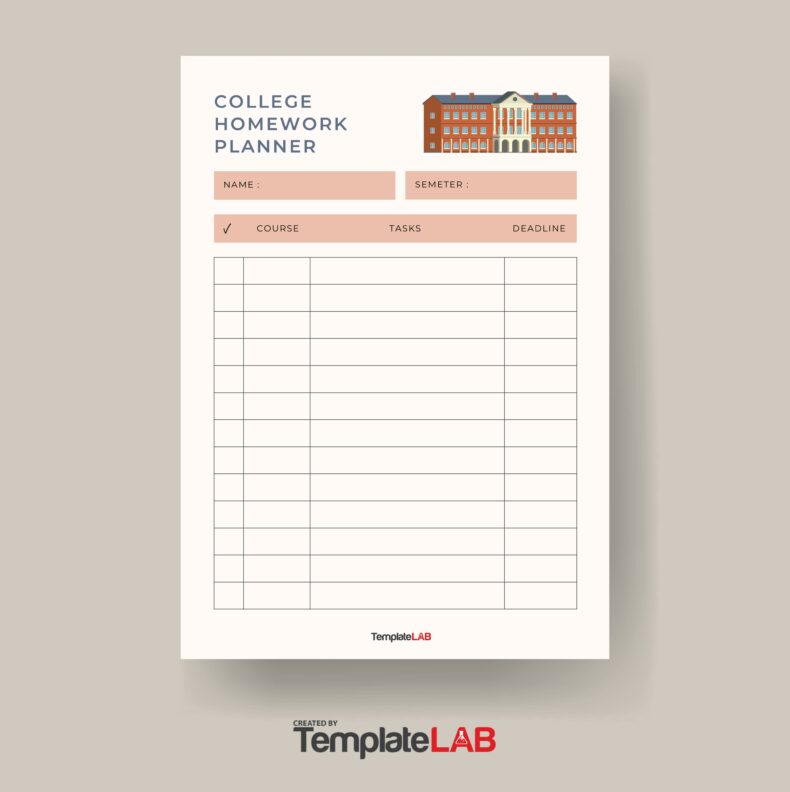
Homework Planners

Attendance Sheet Templates
Search our database of 10,000+ Microsoft Office templates.
Cover Page Designs & Formats for Business Plan in MS Word [Free and Editable]
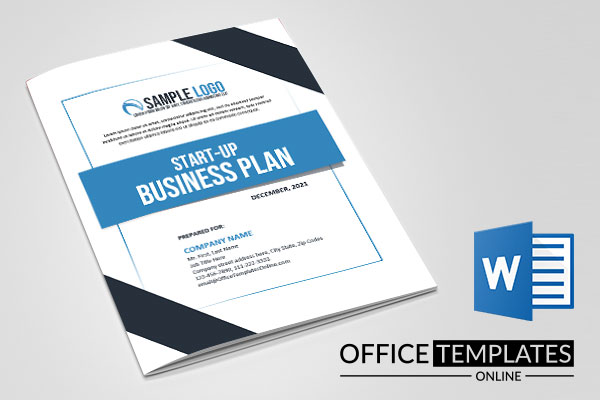
Download Templates
#1 – for startup.

#2 – Feasibility Plan Format
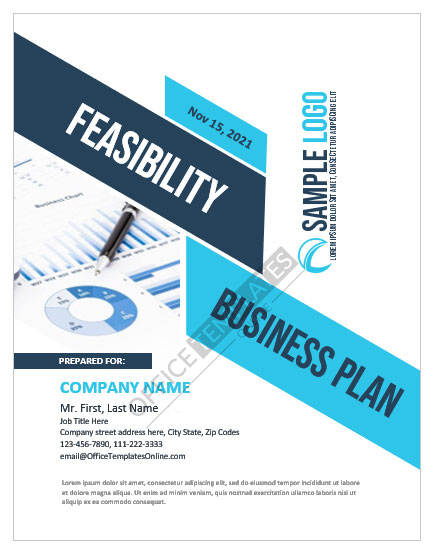
#3 – For Expansion Plan
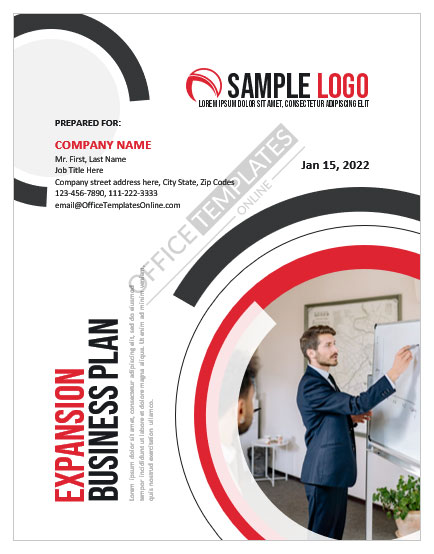
#4 – Best Format for Strategic Business Plan

#5 – Template for Growth Business Plan

#6 – Curvy Design for Internal Business Plan
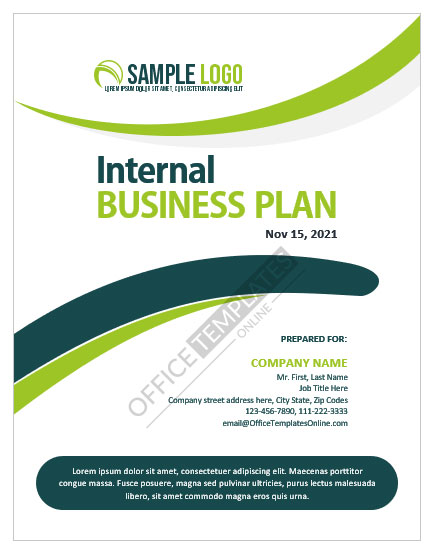
#7 – For Operations Business Plan

Why is a cover page needed in a business plan?
What does it contain.
- Company’s name
- Company’s address and contact information (email, fax, or postal address)
- Company’s logo, design color, and catchphrase or slogan
- Year and date of when the plan has been formulated for
- Serial number
- Name and contact details of the person to be contacted when needed
- Name of the person or key member who prepared it
- A confidentiality statement
- A disclaimer
Why is it vital for a business plan?
- It is the first introduction
- It tells what the document contains from the inside
- It gives information to the reader to get in touch with you
- It professionally conveys the information that the readers are interested in getting
- A carefully planned front page will get you the edge you need and help you stand out among the rest of the companies
Things to avoid
- Inappropriate font size, either too large or too small
- Bad-quality image/company logo
- Unattractive color scheme
- Bad printing quality
- Overcrowded graphic outlook
- A wrong sequence of information
- Informal representation
- Informal font
- Confused or inconsistent alignment of text and image
- Typos or grammatical errors
← Previous Article
Next Article →
You may also like
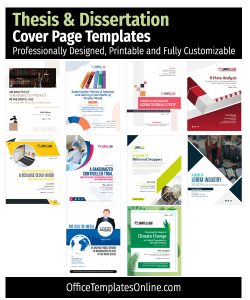
- Doctor Prescription Pad Formats
- Printable ID Cards
- Creative Resume Formats for Freshers
- Modern Resume Templates
- Best Cover Page Formats
- Printable Report Cards
- Business Proposal Templates
- 22 Raffle Ticket Templates
- Free Certificate Templates
- 5+ Free Food Diary Templates to Transform Your Eating Habits
- Make it Memorable: Free 4th of July Flyer Templates
- Say Goodbye with Style: Free Impactful Resignation Letter Templates
- Share Your Appreciation: Free Memorial Day Card Templates
- Crafted with Love: Free Mother’s Day Cards to Warm Mom’s Heart
- Stand Out from the Crowd: 6+ Free Fact Sheet Templates
- Make Your Mark: Free Printable Dog Name Tags for Every Tail-Wagger!
- 7+ Free Stunning Easter Templates for Joyful Celebrations
- 9+ Free Admit-One Ticket Templates: Flexible and Easy to Edit
- Get Cooking with Style: 8+ Free Customizable Recipe Card Templates
- 11+ Free Mortgage Flyer Templates to Elevate Your Marketing
- Enhance Your Events with 20+ Unique and Free Ticket Voucher Templates
- Certificates
- Cover Pages
- Educational
- Event Templates
- Invoices & Receipts
- Letterheads
- Office Related
- Personal Use
- 137+ Professional Reports – MS Word & Excel
- 70+ Printable & Editable ID Card Designs
- 59+ Proposal Formats
- 31+ Best Flyer Designs & Formats
- 100+ Cover Page Templates
- 22+ Free Letterhead Designs and Formats
- 24+ Free Resume Designs & for Freshers and Professionals
- 136+ Printable Certificate Templates
- 55+ Quotations & Invoices
- Create FREE PDF Calendar Online

IMAGES
VIDEO
COMMENTS
Learn what to include and how to format your business plan cover page to make a good impression on stakeholders. See examples of cover page designs and tips to make your cover page memorable.
Learn the importance and elements of a business plan cover page, such as logo, name, title, contact, date, and confidentiality statement. See examples and tips for designing a professional and attractive cover page for your business plan.
Learn the purpose, elements, and format of a business plan cover page, and see examples of templates. A cover page is the first impression of your business, so make it professional, simple, and informative.
Learn how to create a powerful cover page for your business plan that communicates what your company is about and makes a good impression. Find out what elements to include, how to structure them, and see successful examples.
A business plan cover page is important because it serves as the first point of contact for investors and stakeholders. It sets the tone for your business plan and helps create a professional and ...
Learn how to create a visually appealing and informative cover page for your business plan with this guide. Find out the elements to include, the format to use and a template and example to follow.
Learn what to include and how to format a cover page for your business plan to make a good first impression. Find templates, tips, and examples to create a professional and informative cover page.
Learn how to create a professional and attractive cover page for your business plan with these five steps. Find out how to use a template, your logo, a title, company information, and a confidentiality statement.
Learn the importance and essential elements of a business plan cover page, such as logo, name, tagline, color, title, year, and contact information. See an example of a cover page and get tips to make it remarkable.
Learn what a business plan cover page is, why it is important and what to include in it. Follow the steps and tips to create a professional and effective cover page for your business plan.
2. Business name. Add your company name below the title of the document. Use the same font of the title, but increase the font size slightly, so it stands out. Your company name is a significant part of the cover page, so use sharp, bold text that's big enough to read clearly.
Be consistent with alignment. Unless you have an excellent reason for mixing up your alignment, don't. For example, if you choose to left-justify some things, then left-justify all elements on your business plan's cover page. Don't use more than two fonts. I like a sans-serif font (think Arial) for the largest text and a serif font (think ...
1. Cover Page. Your business plan should be prefaced with an eye-catching cover page. This means including a high-resolution image of your company logo, followed by your company's name, address, and phone number. Since this business plan will likely change hands and be seen by multiple investors, you should also provide your own name, role in ...
A business plan cover page serves as a one-page introduction to a comprehensive business plan, capturing the main points of an organization. It includes basic company information, similar to a title page, and allows readers to immediately determine a business plan's purpose with one look. Purpose of a Cover Page.
Learn the key elements and tips to create a professional and attractive cover page for your business plan. Find out what information to include, such as company name, logo, value proposition, contact details, and more.
First, business plan cover page templates should provide a brief summary of the business plan. This is typically done with one or two paragraphs that explain the business and its purpose. The template can then explain how the business will meet customer needs and solve any problems that may exist. Also, business plan cover pages should address ...
A few cover page components are essential, whether you are using an email or sending a hard copy. You should have your company name, address, phone number, email address, Twitter handle, and other ...
Optional: Business plan cover page. Adding a business plan cover page can make your plan, and by extension your business, seem more professional in the eyes of potential investors, lenders, and partners. It serves as the introduction to your document and provides necessary contact information for stakeholders to reference.
First and foremost, your Company's name should be included on the business plan cover page. This should be the most prominent feature of the cover page, and as such, is traditionally in the largest font setting. Immediately, the reader should know the name of your company. 2. Company Logo and Color Scheme.
Business Plan Cover Page Template. Download for Word Download for PowerPoint Download for Photoshop . Exclusive ... Here are some steps to follow if you plan to design your own portfolio cover page: Choose one of the pre-formatted templates from the Insert tab then start editing the template. Change the colors, font styles, and all the other ...
It must be comprised of: Things that CANNOT be missed, such as: Company's name. Title. Company's address and contact information (email, fax, or postal address) Things CAN be missed but are better once added: Company's logo, design color, and catchphrase or slogan. Year and date of when the plan has been formulated for.